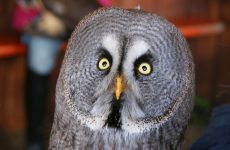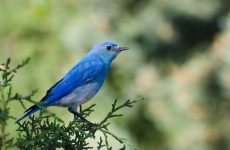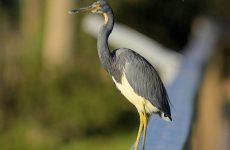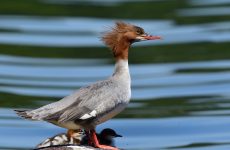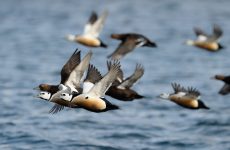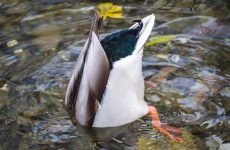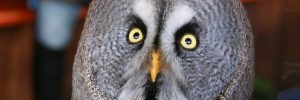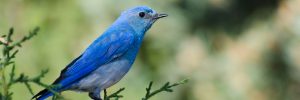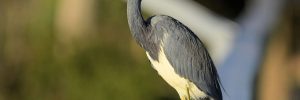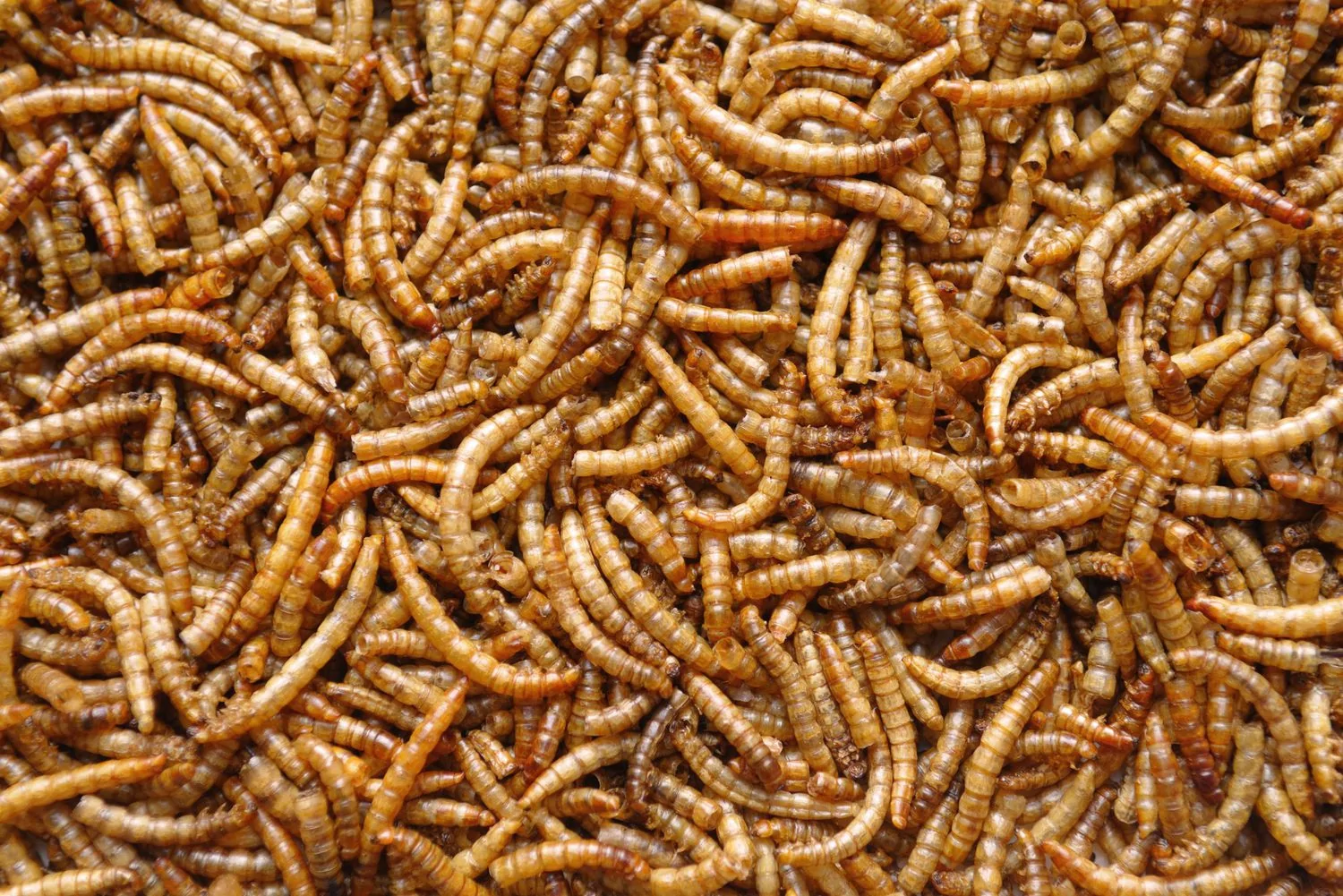
The most well-known birds to eat mealworms are robins and blue jays, but there are loads more species you can attract to your yard with these tasty treats. Some birds won’t visit bird feeders and eat a diet mainly of insects, so mealworms are your best option to attract these birds.
Birds that are attracted to mealworms include robins, jays, woodpeckers, chickadees, nuthatches, mockingbirds, bluebirds, thrashers, cardinals, and some wrens and warblers.
Dried or Live Mealworms – Which Is Best?
Mealworms are actually the larvae of a beetle and are just the right food to serve up as a protein-rich meal. Both live and dried mealworms are equally fine to serve to birds, but they will prefer the live ones wriggling about. However, for convenience and cost, the dried ones are a great alternative.
Live mealworms are more expensive and need to be kept in the fridge, and won’t last as long as dried. Dried are cheaper and last a long time.
How To Serve Mealworms
Some birds will eat out of your hand if offered mealworms, but serving them on a platform feeder or on the ground is fine. However, if you are using live mealworms, then use a dish with sides.
Birds may not immediately start eating dried mealworms, but you can soak them a little beforehand or
What Birds Eat Mealworms In Winter
Winter is a great time to feed birds mealworms as food is more scarce. Many of the birds that eat mealworms do not migrate, and as the weather turns cold, they appreciate these yummy morsels.
Birds that eat mealworms in winter are robins, jays, woodpeckers, chickadees, titmouses, and nuthatches.
31 Birds That Eat Mealworms:
1. American Robin
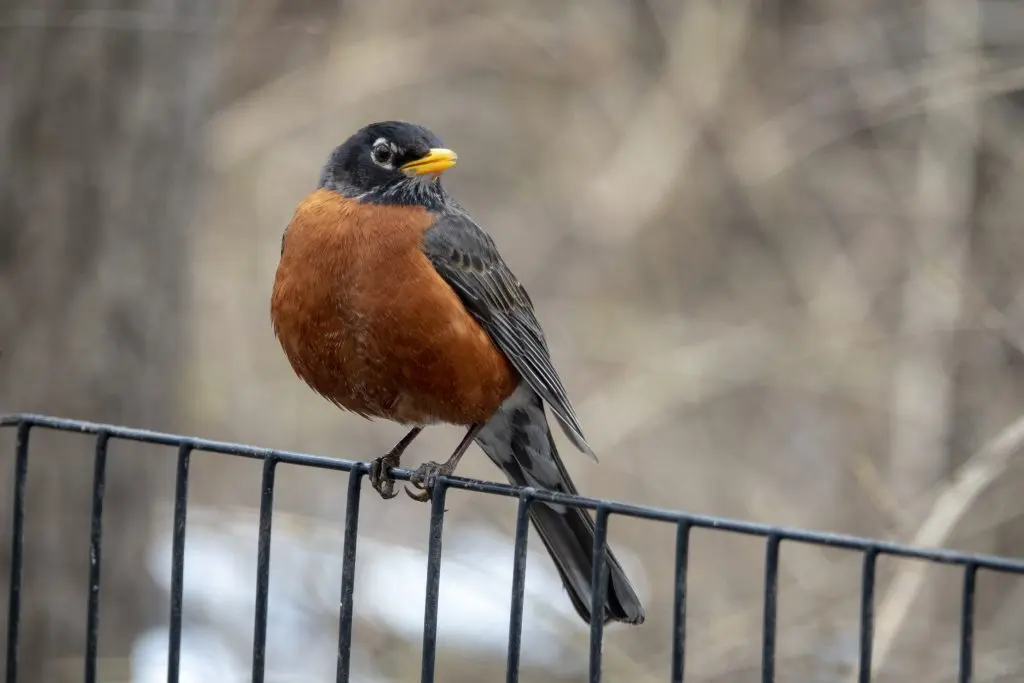
American Robins are a common sight on lawns eating earthworms. They have black heads and backs with red or orange breasts. They tend to roost in trees in winter, so you are more likely to see them in your backyard from spring.
- Turdus migratorius
- Length: 7.9-11.0 in (20-28 cm)
- Weight: 2.7-3.0 oz (77-85 g)
- Wingspan: 12.2-15.8 in (31-40 cm)
American Robins are residents in the lower 48 and the coast of Western Canada and Alaska. Those that breed in Canada and inland Alaska move south for the winter.
American Robins can be found in many habitats, from woodlands, forests, and mountains to fields, parks, and lawns. They eat earthworms, insects, snails, and fruit.
American Robin Song:
American Robin Call:
Attract American Robins to your backyard with sunflower seeds, suet and peanut hearts, fruit, and mealworms. Platform feeders are best or food scattered on the ground. Also, try planting some native plants that produce berries, such as juniper, sumac, hawthorn, and dogwood.
2. Blue Jay
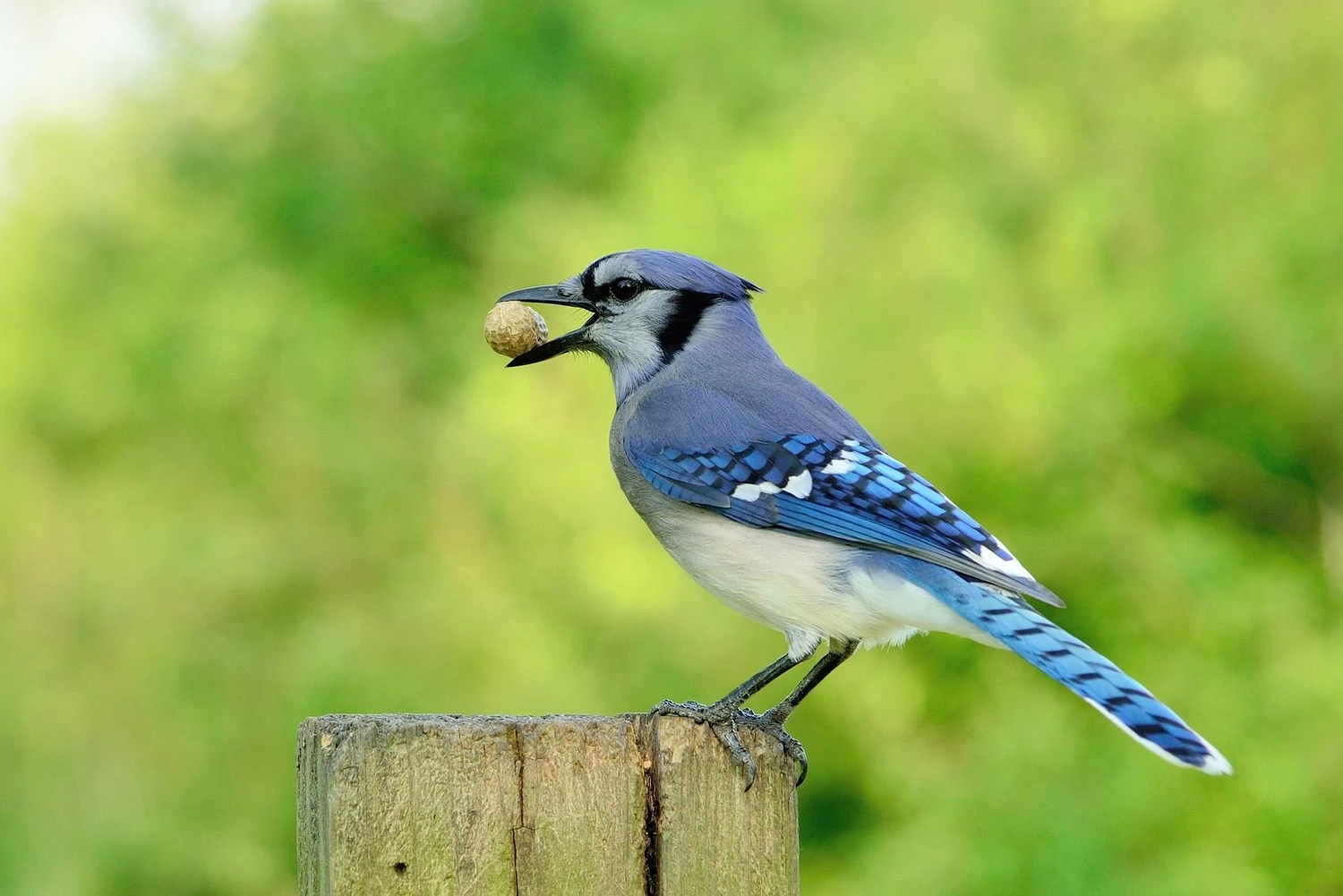
Blue Jays are common large songbirds with a blue upright crest, blue and black backs, and white undersides.
- Cyanocitta cristata
- Length: 9.8-11.8 in (25-30 cm)
- Weight: 2.5-3.5 oz (70-100 g)
- Wingspan: 13.4-16.9 in (34-43 cm)
Blue Jays live in eastern US states and Southern Canada all year. Some birds will migrate west for winter but not very frequently.
They are noisy birds that travel in family groups eating acorns when available. They can be found in forests, mainly near oak, as they eat acorns. They can also be found in backyards near feeders. As well as acorns, they eat insects, nuts and seeds, and grain. They may also take eggs from nests or take nestlings.
Blue Jay Call:
Blue Jays are large birds and prefer to fly in, grab a peanut or sunflower seed and take it away to feed. They prefer platform or tray feeders to make it easy to make a quick exit.
Attract Blue Jays to your backyard with peanuts, sunflower seeds, and suet. They prefer these on open tray feeders or hopper feeders on a post. They will also enjoy a birdbath.
3. Downy Woodpecker
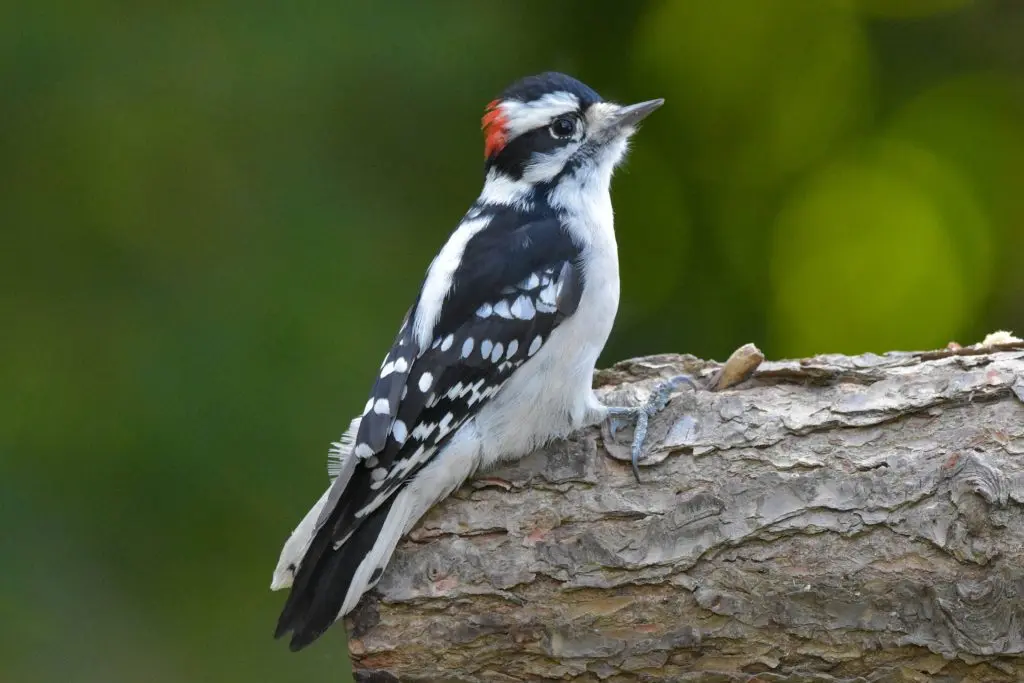
Downy Woodpeckers are small birds that are common at backyard feeders. They are often mixed in with other birds, such as chickadees and nuthatches.
They have black and white coloring with a red patch at the back of their heads. They look similar to the Hairy Woodpecker but smaller.
- Dryobates pubescens
- Length: 5.5-6.7 in (14-17 cm)
- Weight: 0.7-1.0 oz (21-28 g)
- Wingspan: 9.8-11.8 in (25-30 cm)
Downy Woodpeckers do not migrate and can be spotted in most states and provinces, except the north of Canada.
You can find Downy woodpeckers in woodlots, along streams, city parks, and backyards, and they eat mainly insects and beetle larvae but also berries, acorns, and grains.
Downy Woodpecker Call:
Attract Downy Woodpeckers to your backyard with their favorite treat of suet, but they will also eat black oil sunflower seeds, millet, and peanuts on platform feeders.
4. Red-bellied Woodpecker
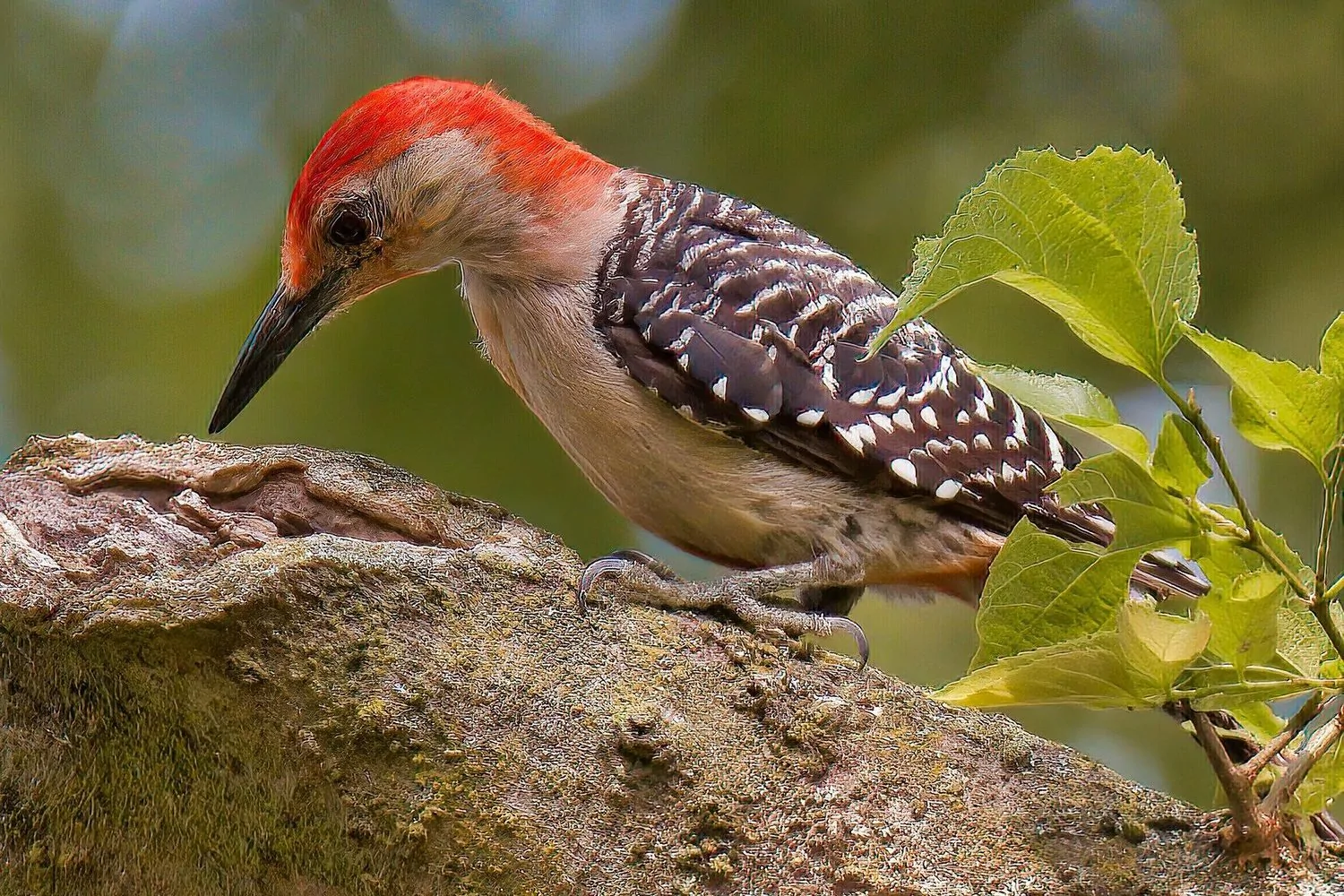
Red-bellied Woodpeckers can be mistaken for Red-headed Woodpeckers as they have red caps, but they are much smaller than the Red-headed Woodpecker. Female Red-bellied Woodpeckers lack the red cap and only have red at the back of their heads.
They also have a very pale red belly that can be hard to spot, but they do have the typical woodpecker black and white markings over their backs.
- Melanerpes carolinus
- Length: 9.4 in (24 cm)
- Weight: 2.0-3.2 oz (56-91 g)
- Wingspan: 13.0-16.5 in (33-42 cm)
Red-bellied Woodpeckers can be found in eastern US states, and they do not migrate.
Red-bellied Woodpeckers eat insects, spiders, seeds from grasses, fruit, and nuts. They will also sometimes eat nestlings. They nest in dead trees and may use the same nest year after year. They lay 4-5 white eggs on a bed of wood chips.
The tongue of the Red-bellied Woodpecker sticks out 2 inches past the beak and is barbed at the tip, along with sticky spit. This helps catch prey from deep crevices.
Red-bellied Woodpecker Call:
Red-bellied Woodpeckers can often be seen at bird feeders, especially if you live near wooded areas. They make a distinctive loud rolling call which means you will often hear them before you see them.
5. Black-capped Chickadee
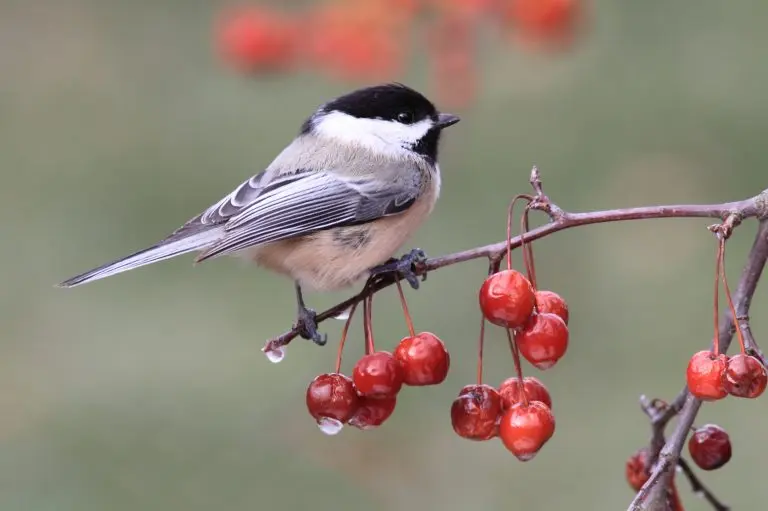
The Black-capped Chickadee is a cute bird with a big round head and tiny body. These birds will happily feed at backyard feeders and investigate everything, including you!
They have black caps and beaks, white cheeks, and are gray on the back, wings, and tail.
- Poecile atricapillus
- Length: 4.7-5.9 in (12-15 cm)
- Weight: 0.3-0.5 oz (9-14 g)
- Wingspan: 6.3-8.3 in (16-21 cm)
Black-capped Chickadees do not migrate and can be spotted in the northern half of the US and Canada.
You can find them in forests, open woods, and parks. Black-capped Chickadees eat seeds, berries and insects, spiders, and suet.
Black-capped Chickadee Call/Song:
Attract Black-capped Chickadees to your backyard with suet, sunflower seeds, and peanuts or peanut butter. They will even feed from your hand and are often one of the first birds to discover new feeders. They will also use nest boxes, especially if you fill them with wood shavings.
6. Tufted Titmouse
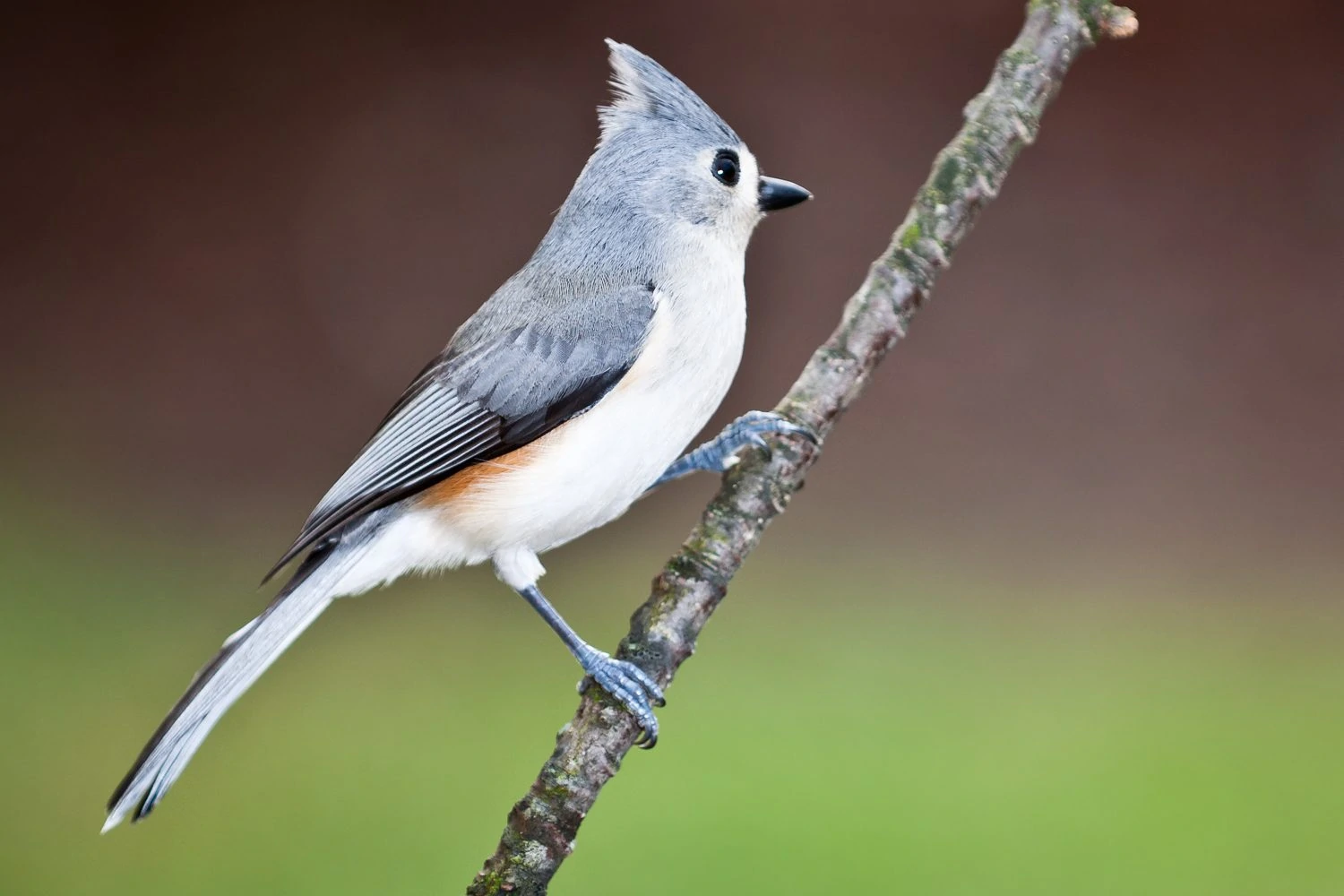
Tufted Titmouses is gray on the back and white underneath with a cute gray crest and large eyes. They often flock with chickadees, nuthatches, and woodpeckers.
- Baeolophus bicolor
- Length: 5.5-6.3 in (14-16 cm)
- Weight: 0.6-0.9 oz (18-26 g)
- Wingspan: 7.9-10.2 in (20-26 cm)
Tufted Titmouses live in eastern and southeastern US states all year
You can find Tufted Titmouses in woodlands, parks, and backyard feeders, and they can be assertive over smaller birds, pushing in to get to the food first.
Tufted Titmouses eat mostly insects in summer, including caterpillars, beetles, ants, and wasps, as well as spiders and snails. They will also eat seeds, nuts, and berries and will hoard shelled seeds.
Tufted Titmouse Song:
Attract Tufted Titmice to your backyard feeders with sunflower seeds, suet, and peanuts on tube feeders or suet cages. They will also eat from platform feeders. You can also try putting up a nest box to attract a breeding pair.
7. White-breasted Nuthatch
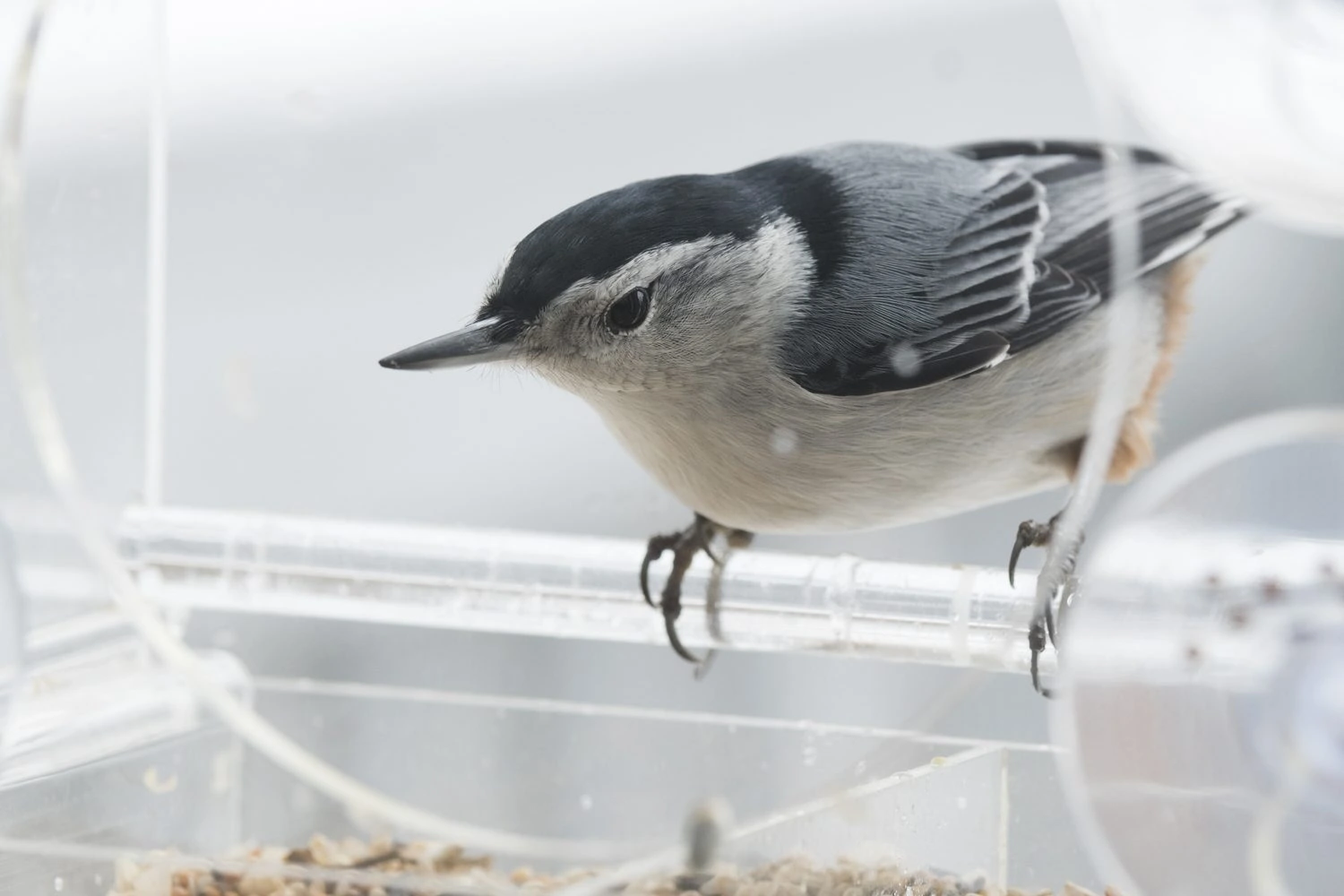
White-breasted Nuthatches are active little birds that are gray-blue on the back and white on the face and belly, with a black cap. They will often have a chestnut color on the lower belly and under the tail.
- Sitta carolinensis
- Length: 5.1-5.5 in (13-14 cm)
- Weight: 0.6-1.1 oz (18-30 g)
- Wingspan: 7.9-10.6 in (20-27 cm)
White-breasted Nuthatches live all year in the US and southern Canada.
You can find White-breasted Nuthatches in deciduous forests, woodland edges, parks, and yards with trees or at feeders. They mainly eat insects, including beetles and their larvae, caterpillars, ants, and also spiders.
White-breasted Nuthatches also eat seeds and nuts, including acorns, hawthorns, sunflower seeds, and sometimes corn crops. They jam large nuts and acorns into tree bark and then whack them with their bills to open or ‘hatch’ them to get the seed out.
White-breasted Nutcracker Call:
Attract White-breasted Nuthatches to your backyard with sunflower seeds and peanuts on tube feeders or suet feeders.
8. Carolina Wren
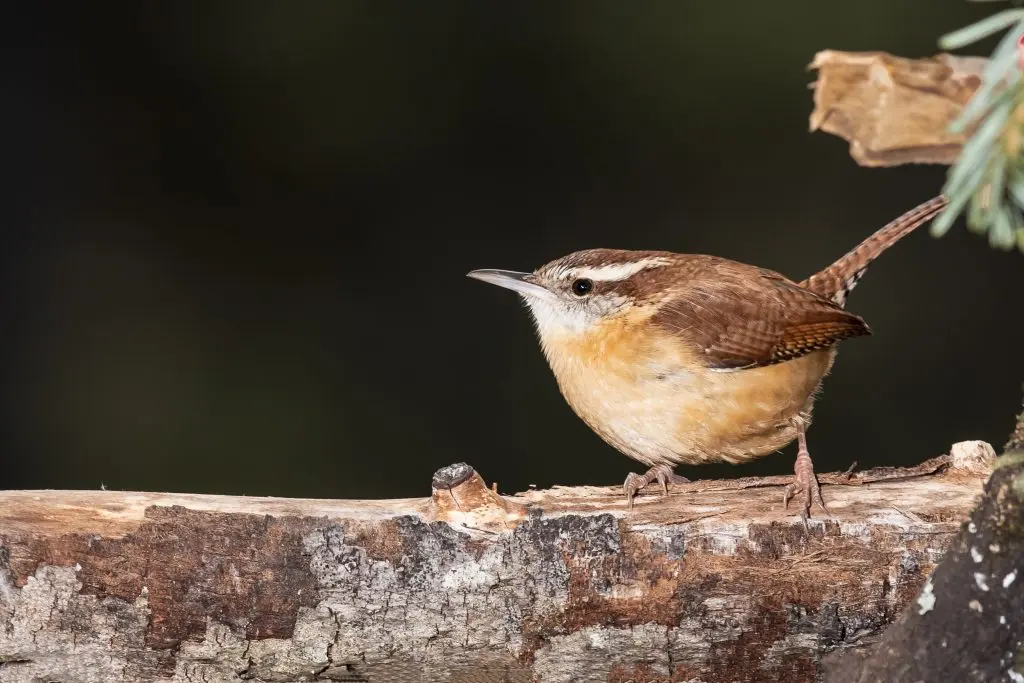
Carolina Wrens are shy birds that are dark brown on top and light brown underneath. They have a white eyebrow stripe and upright tail, and a loud ‘teakettle‘ song.
- Thryothorus ludovicianus
- Length: 4.7-5.5 in (12-14 cm)
- Weight: 0.6-0.8 oz (18-22 g)
- Wingspan: 11.4 in (29 cm)
Carolina Wrens are residents all year across eastern and southeastern US States.
You can find them in woods or thickly vegetated areas, and they will visit backyard feeders.
Carolina Wren Song:
Attract Carolina Wrens to your backyard feeders with suet feeders, hulled sunflower seeds, or peanut hearts in large tube feeders or on platform feeders.
9. Northern Mockingbird
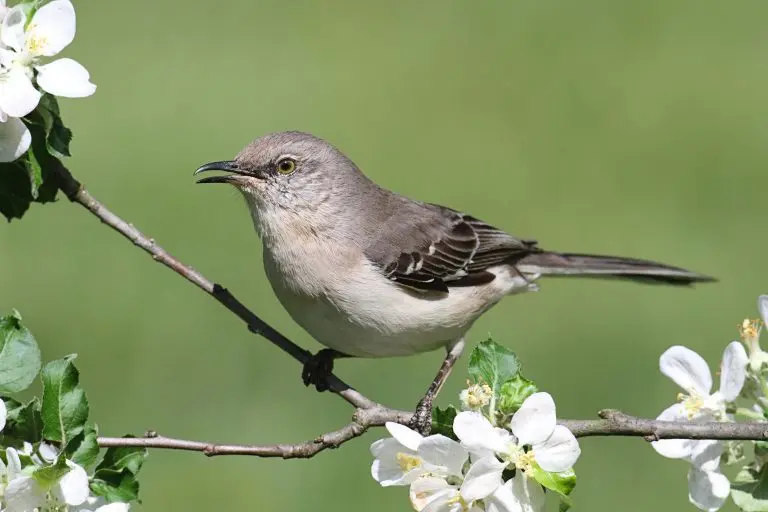
Northern Mockingbirds are medium-sized songbirds with small heads and long tails. They are a gray-brown color and slightly paler on the underside than their back, and they have two white wingbars visible in flight.
- Mimus polyglottos
- Length: 8.3-10.2 in (21-26 cm)
- Weight: 1.6-2.0 oz (45-58 g)
- Wingspan: 12.2-13.8 in (31-35 cm)
Northern Mockingbirds do not migrate and can be spotted across the lower 48 and southern Canada.
They are usually seen alone or in pairs and aggressively defend their territory. A male mockingbird can learn around 200 songs in its life, copying other birds’ songs, and they can sing all through the day and into the night.
Northern Mockingbird Call/Song:
Attract more Northern Mockingbirds to your backyard by planting fruiting trees or bushes, including hawthorns, mulberries, and blackberry brambles. They don’t often visit feeders, but they will come to open lawn areas.
10. Yellow-rumped Warbler
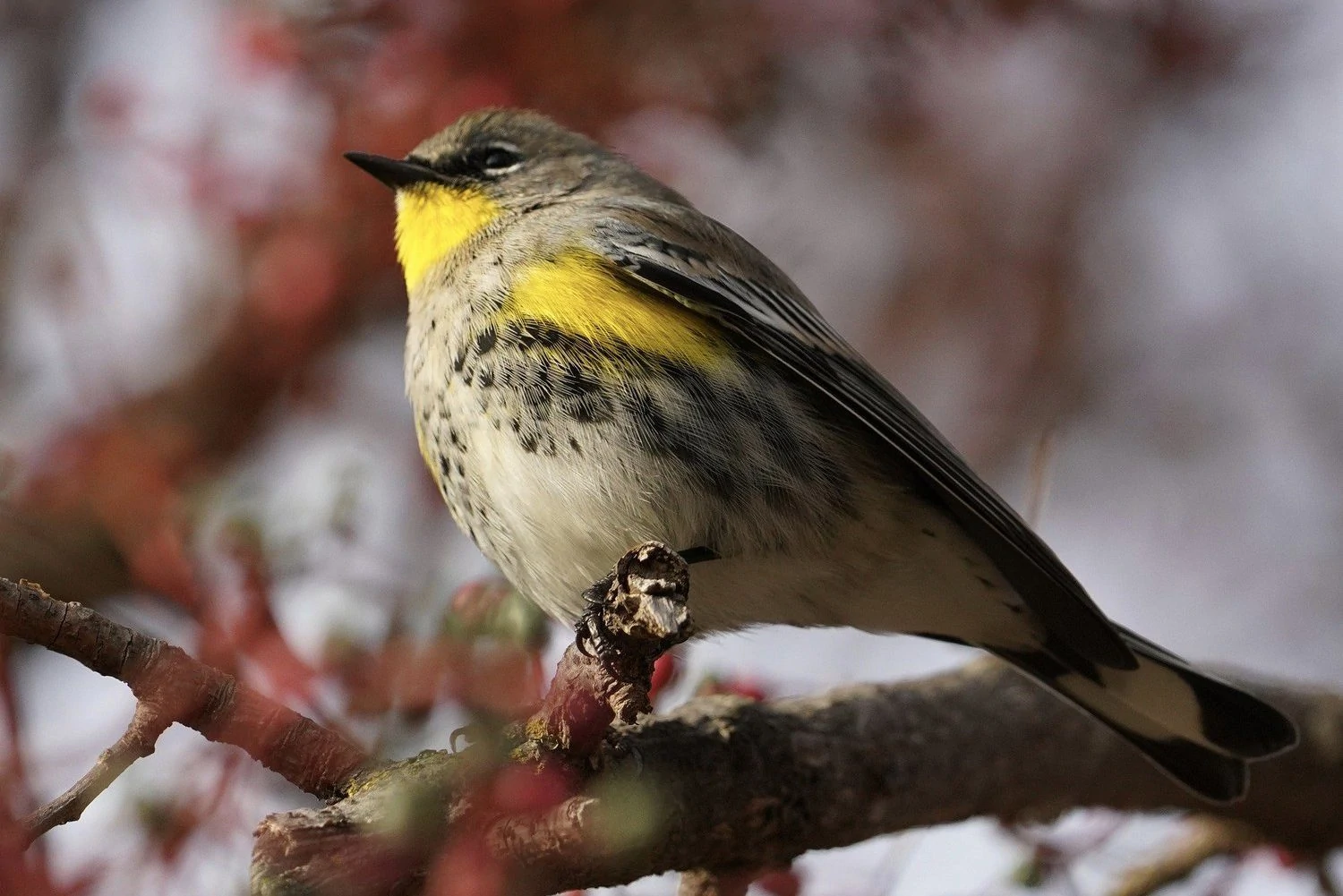
Yellow-rumped Warblers are gray with flashes of yellow on the face, sides, and rump and white in the wings.
Females may be slightly brown, and winter birds are paler brown with bright yellow rumps and sides turning bright yellow and gray again in spring.
- Setophaga coronata
- Length: 4.7-5.5 in (12-14 cm)
- Weight: 0.4-0.5 oz (12-13 g)
- Wingspan: 7.5-9.1 in (19-23 cm)
Yellow-rumped Warblers breed predominantly in Canada and parts of the Rockies and the Appalachian mountains.
During migration, they can be seen in the Midwest before overwintering in southern and southwestern US states and the Pacific Coast and into Mexico and Central America.
You can find Yellow-rumped Warblers in coniferous forests, especially during the breeding season. During winter, they can be found in open areas with fruiting shrubs. In summer, they eat mostly insects and on migration, and in winter, they eat mostly fruit, including bayberry and wax myrtle.
Yellow-rumped Warbler Song:
Attract Yellow-rumped Warblers to your backyard with sunflower seeds, suet, raisins, and peanut butter.
11. Carolina Chickadee
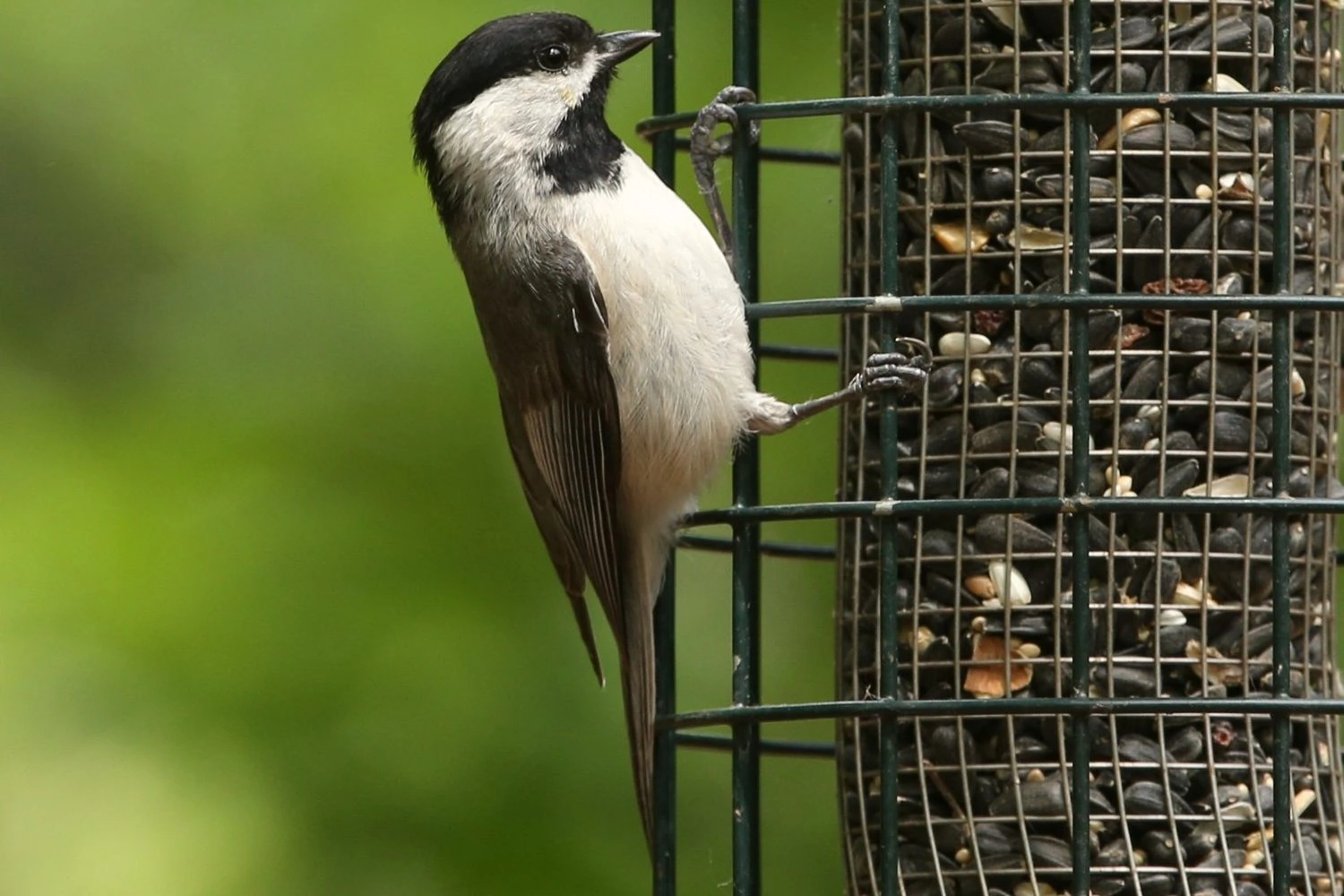
Carolina Chickadees are tiny birds with large heads, black caps and necks, white cheeks and bellies, and soft gray backs, wings, and tails.
They are visually very similar to the Black-capped Chickadee, and they interbreed where their range overlaps.
- Poecile carolinensis
- Length: 3.9-4.7 in (10-12 cm)
- Weight: 0.3-0.4 oz (8-12 g)
- Wingspan: 5.9-7.9 in (15-20 cm)
Carolina Chickadees can be found in forested areas, parks, and backyards in eastern and southeastern US states all year.
Carolina Chickadee Song:
Attract Carolina Chickadees to your backyard feeders with black oil sunflower seeds, nyjer seeds, suet feeders, or peanuts. They will feed on most types of feeders, including tube feeders, suet cages, or platform feeders. They will also nest in nest boxes or nest tubes.
12. Eastern Bluebird
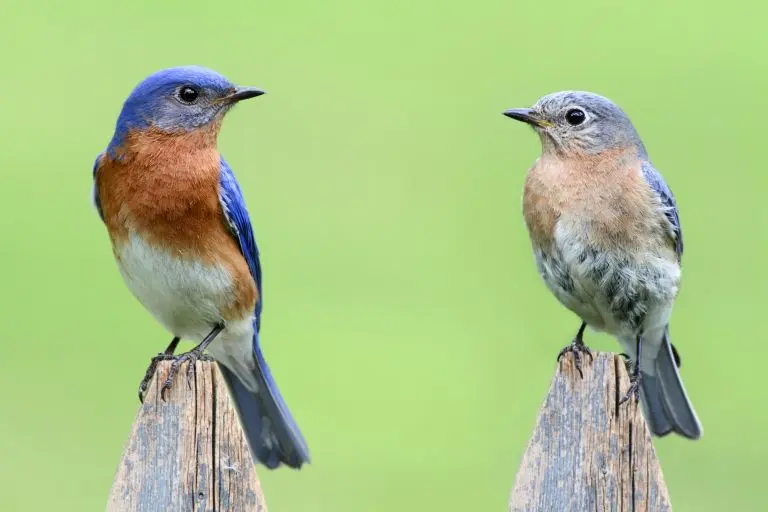
Eastern Bluebirds are small thrushes with big, rounded heads, large eyes, and big bellies.
The males are deep blue on the back and a reddish color underneath. Females are grayer above with some blue in the wings and tail and a less vivid orange-brown breast.
- Sialia sialis
- Length: 6.3-8.3 in (16-21 cm)
- Weight: 1.0-1.1 oz (28-32 g)
- Wingspan: 9.8-12.6 in (25-32 cm)
They live all year in southeastern US states, but those that breed in the northern US and southern Canada migrate south.
You can find Eastern bluebirds in meadows, and they can often be spotted perched on wires and posts or low branches, looking for insects.
Eastern Bluebird Song:
Attract Eastern Bluebirds to your backyard by offering mealworms and nest boxes if your yard is pretty open and spacious.
13. Ruby-crowned Kinglet
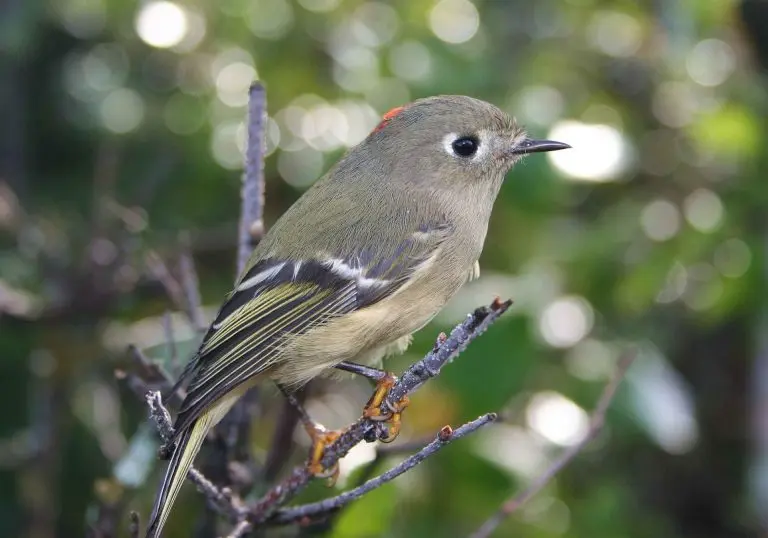
Ruby-crowned Kinglets are small songbirds that are olive-green, and the males have a brilliant red crown that is usually flat, so hard to see.
- Corthylio calendula
- Length: 3.5-4.3 in (9-11 cm)
- Weight: 0.2-0.3 oz (5-10 g)
- Wingspan: 6.3-7.1 in (16-18 cm)
Ruby-crowned Kinglets breed in Canada and the mountainous west before migrating to southern and southwestern US states and Mexico for the winter.
Ruby-crowned Kinglets can be hard to spot as they are fast-moving quiet birds that flit around in the foliage of lower branches and shrubs and trees looking for spiders and insects.
Ruby-crowned Kinglet Song:
Attract Ruby-crowned Kinglets with suet or platform feeders with hulled sunflower seeds, peanut hearts, and mealworms.
14. Hairy Woodpecker
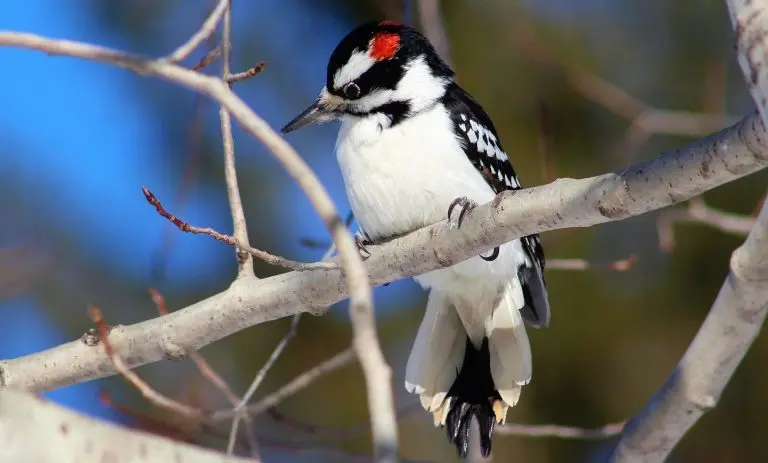
Hairy Woodpeckers are medium-sized woodpeckers with a black and white pattern and a large white patch on their backs. The males have a flash of red towards the back of their heads.
They are visually similar to Downy Woodpeckers but larger and with longer bills. As they are often found in the same areas, it is hard to tell them apart if they are not near each other.
- Dryobates villosus
- Length: 7.1-10.2 in (18-26 cm)
- Weight: 1.4-3.4 oz (40-95 g)
- Wingspan: 13.0-16.1 in (33-41 cm)
Hairy Woodpeckers do not migrate and live in all US states and Canada, except the far north of Canada.
You can find Hairy Woodpeckers in woodlands on trunks or main branches of large trees, but they are also found in a wide variety of habitats, including woodlots, parks, and cemeteries. Hairy Woodpeckers’ diet is mostly insects.
Hairy Woodpecker Call/drumming:
Attract Hairy Woodpeckers to your backyard with suet feeders.
15. Pileated Woodpecker
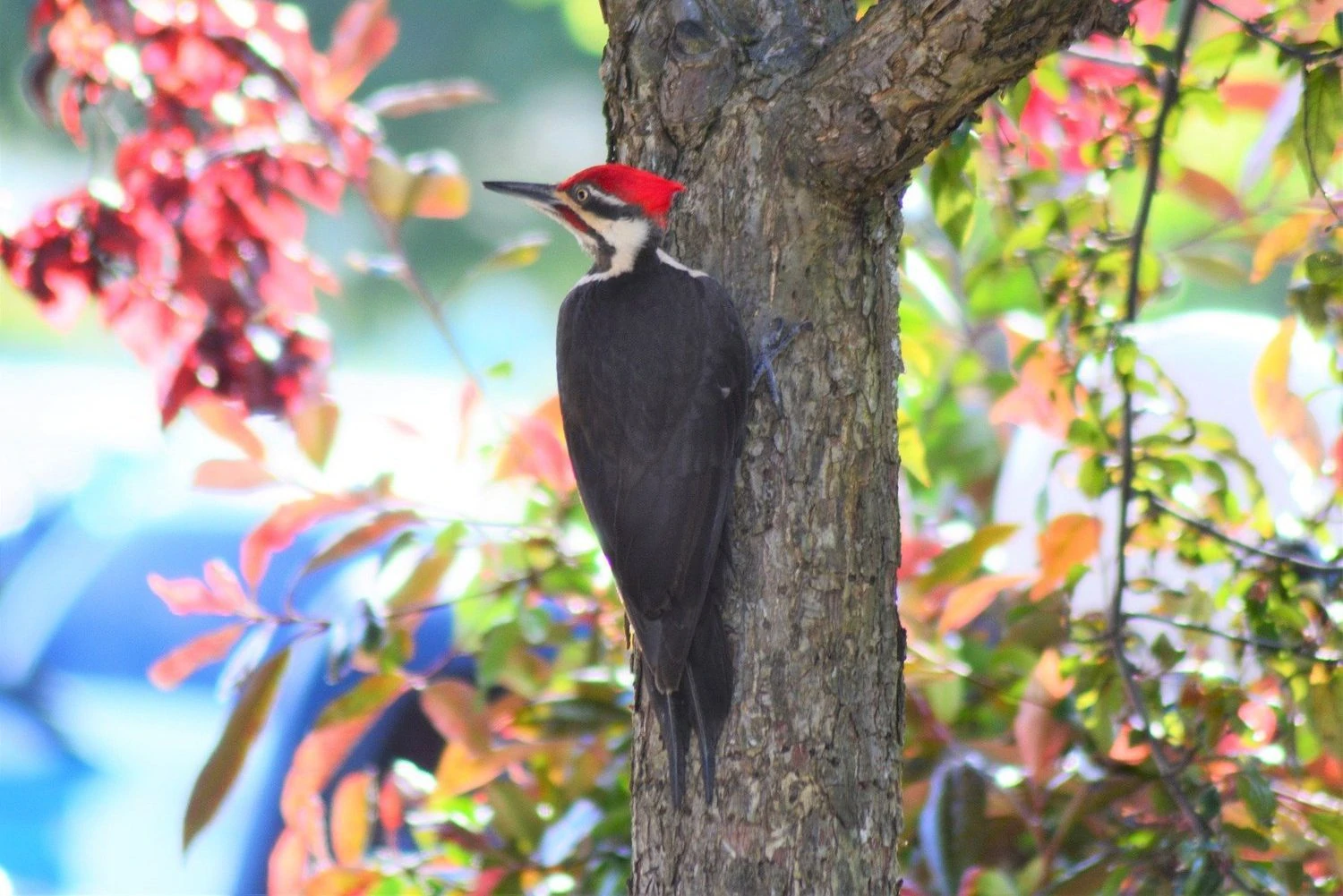
Pileated Woodpeckers are the biggest woodpecker in North America, and their flaming-red triangular crest is very striking.
They are black with a white stripe, and when flying, the white underside of the wings can be seen. Males have an additional red stripe on the cheek.
- Dryocopus pileatus
- Length: 15.8-19.3 in (40-49 cm)
- Weight: 8.8-12.3 oz (250-350 g)
- Wingspan: 26.0-29.5 in (66-75 cm)
They live all year in eastern US states, across Canada, and into northwestern US states.
Pileated Woodpeckers mostly eat carpenter ants from dead trees and fallen logs, but they also eat beetle larvae, termites, and other insects as well as fruit and nuts such as blackberries, sumac berries, dogwood, and elderberry. They make a loud shrill, whinnying call and deep, loud drumming.
Pileated Woodpecker Call:
Attract Pileated Woodpeckers to your backyard with suet feeders that have tail props.
16. Red-breasted Nuthatch
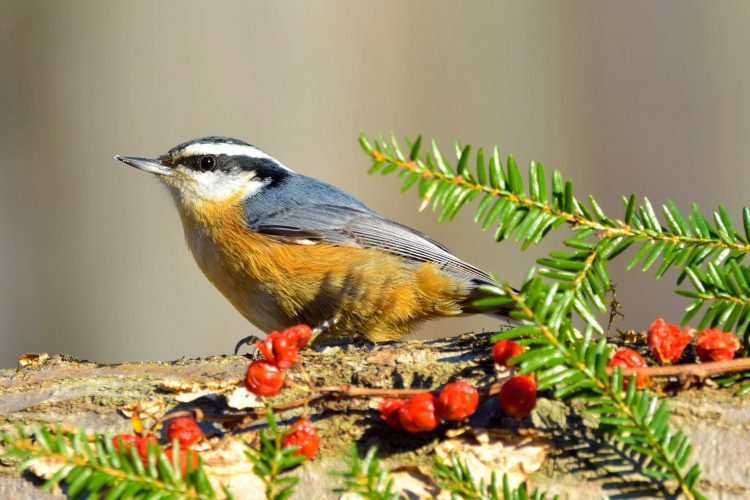
Red-breasted Nuthatches are blue-gray birds with black and white stripes on their heads and a rusty underside.
- Sitta canadensis
- Length: 4.3 in (11 cm)
- Weight: 0.3-0.5 oz (8-13 g)
- Wingspan: 7.1-7.9 in (18-20 cm)
Red-breasted Nuthatches remain all year in northeastern and western states, Alaska and Canada but may move south in winter if cone crops are poor.
You can find Red-breasted Nuthatches in coniferous woods foraging for cones, and they also visit backyard feeders.
Red-breasted Nuthatch Call:
Attract Red-breasted Nuthatches to your backyard with black oil sunflower seeds, suet feeders, peanuts, and mealworms.
17. California Scrub-Jay
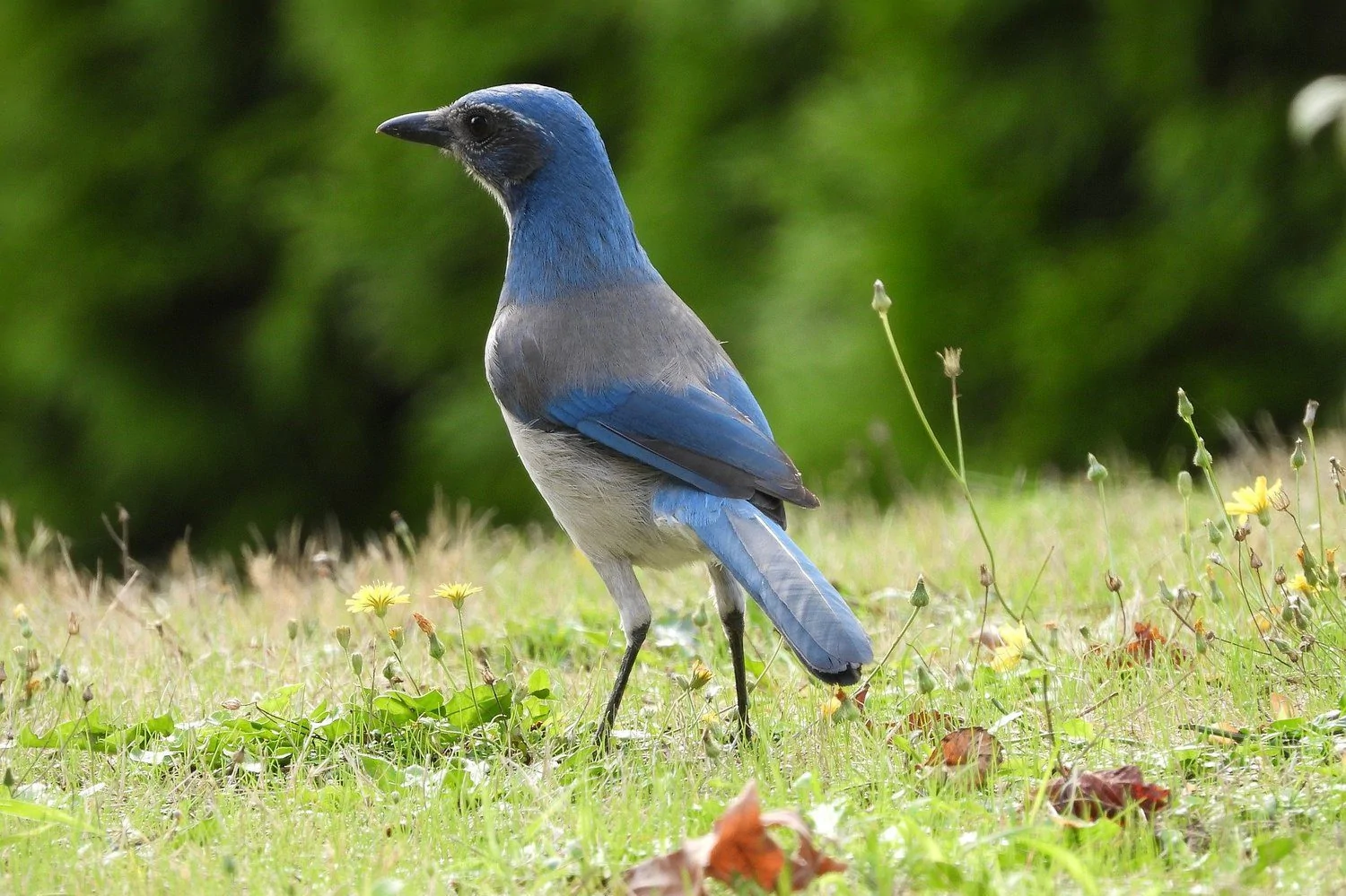
California Scrub-Jays are large songbirds with long tails, whitish undersides and rich blue and gray backs, and a bright blue breast band. They are larger than a robin but smaller than a crow. They look visually similar to the Woodhouse’s Scrub-Jay but with more vivid colors.
- Aphelocoma californica
- Length: 11.0-11.8 in (28-30 cm)
- Weight: 2.5-3.5 oz (70-100 g)
- Wingspan: 15.3 in (39 cm)
California Scrub-Jays are resident all year on the Pacific Coast from British Columbia down to Baja California.
You can find California Scrub-Jay in scrub, oak woodlands, and in suburban yards and parks. They eat insects and fruit during spring and summer and then seeds and nuts, especially acorns, in fall and winter.
California Scrub-Jay sounds: Their call is high-pitched and repetitive. They also sing a courtship song of soft whistles.
Nests of California Scrub-Jay are usually hidden in oak trees and can take up to 10 days to construct the nest made of twigs and a soft lining. They lay 1 – 5 eggs, and the eggs take around 17 – 19 days to hatch.
Attract California Scrub-Jays to your backyard with sunflower seeds and peanuts in your feeders.
Fun fact: California Scrub-Jay will screech over the body of a dead jay and invite others to do the same, and this can last up to half an hour, according to the University of California – Davis
18. Steller’s Jay
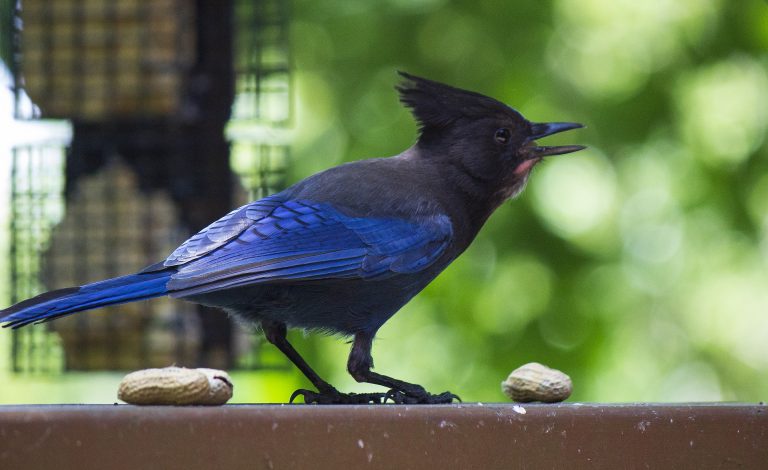
Steller’s Jays are large songbirds with black triangular crests that stick up from their heads. The rest of their heads and onto their chests and back are black, with the rest of their bodies being blue.
- Cyanocitta stelleri
- Length: 11.8-13.4 in (30-34 cm)
- Weight: 3.5-4.9 oz (100-140 g)
- Wingspan: 17.3 in (44 cm)
Steller’s Jays are resident in western US states, western Canada, Mexico, and Central America.
You can find Steller’s Jays in evergreen forests in the mountains, and they will also be found around picnic tables, campgrounds, and backyard feeders.
Steller’s Jays eat most things they can forage for, including insects, seeds, nuts, berries, eggs, and nestlings, but also make a nuisance of themselves around garbage and your unguarded picnic!
Steller’s Jay sounds: They make ‘kaw’ sounds as well as fast two-toned calls, peeps, and harsh guttural sounds. Steller’s Jays can also mimic other noises such as other bird species and even sprinklers and alarms.
Nests of Stellar’s Jays are usually near the top of conifer trees and are built from leaves and plant material held together with mud and lined with soft pine needles.
Attract Steller’s Jays to your backyard with peanuts and suet.
Fun fact: Stellar’s Jays make nests out of the mud.
19. Woodhouse’s Scrub-Jay
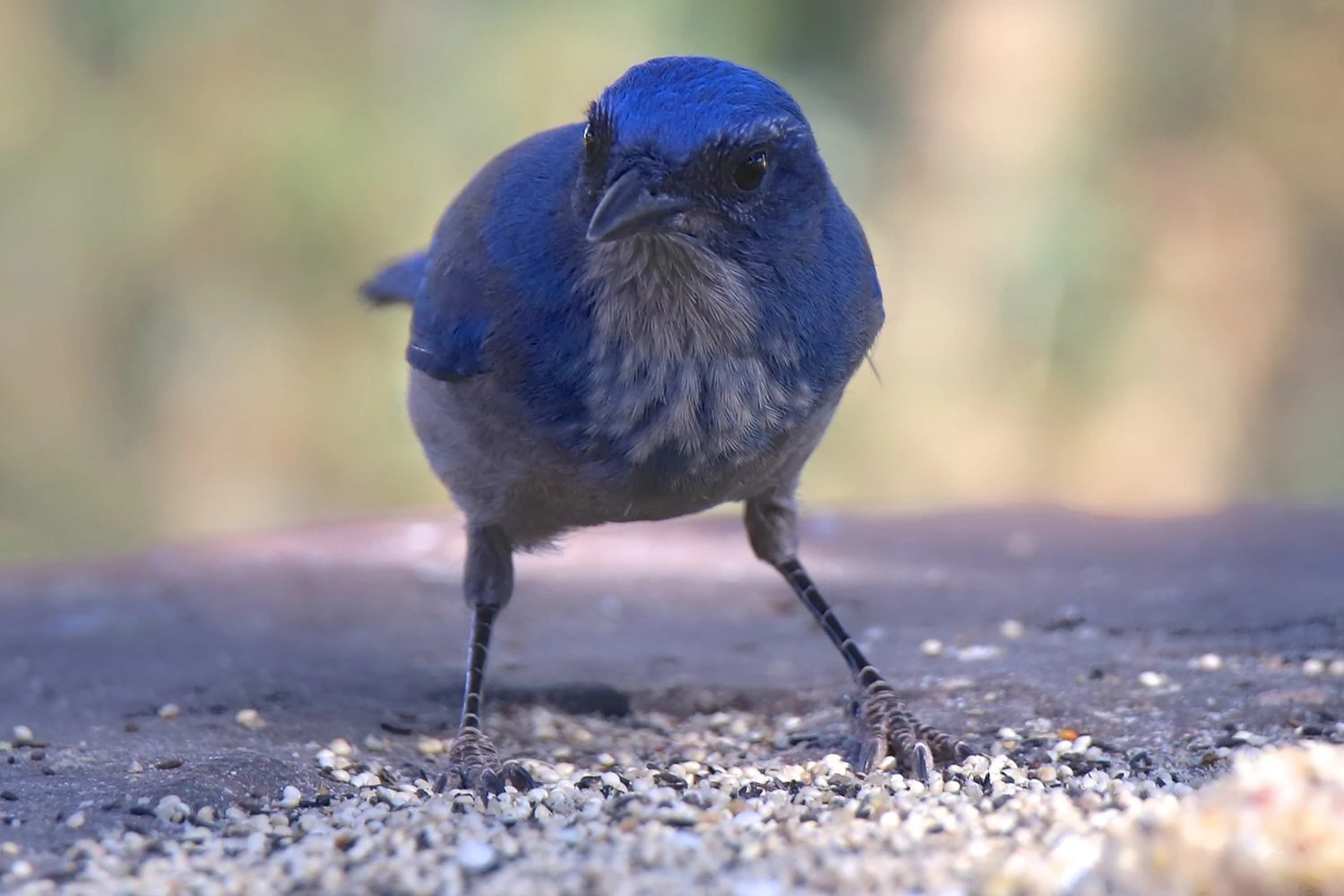
Woodhouse’s Scrub-Jays are the Blue-Jays of the Southwest with lovely blue and gray coloring. They are light blue and dark gray on the back and light gray underneath. Their tails are long and blue.
They are duller in color than California Scrub-Jays and have only a small necklace, and lack the crests of Blue Jays and Stellar’s Jays.
- Aphelocoma woodhouseii
- Length: 11.0-11.8 in (28-30 cm)
- Weight: 2.5-3.5 oz (70-100 g)
Woodhouse’s Scrub-Jays are resident inland in southwest US states and Mexico. You can find them in wooded areas with pinyon-juniper and scrubby areas.
Insects and fruit make up most of the diet of Woodhouse’s Scrub-Jays in summer and nuts and seeds in winter.
Woodhouse’s Scrub-Jay sounds:
Nests of Woodhouse’s Scrub-Jay are fairly simple platforms made of twigs and lined with moss and grass.
Attract Woodhouse’s Scrub-Jays to your backyard with sunflower seeds and peanuts.
Fun Fact: Woodhouse’s Scrub-Jays are thieves that steal food from other birds’ stores, especially Acorn Woodpeckers’ granary tree store of acorns.
20. Clark’s Nutcracker
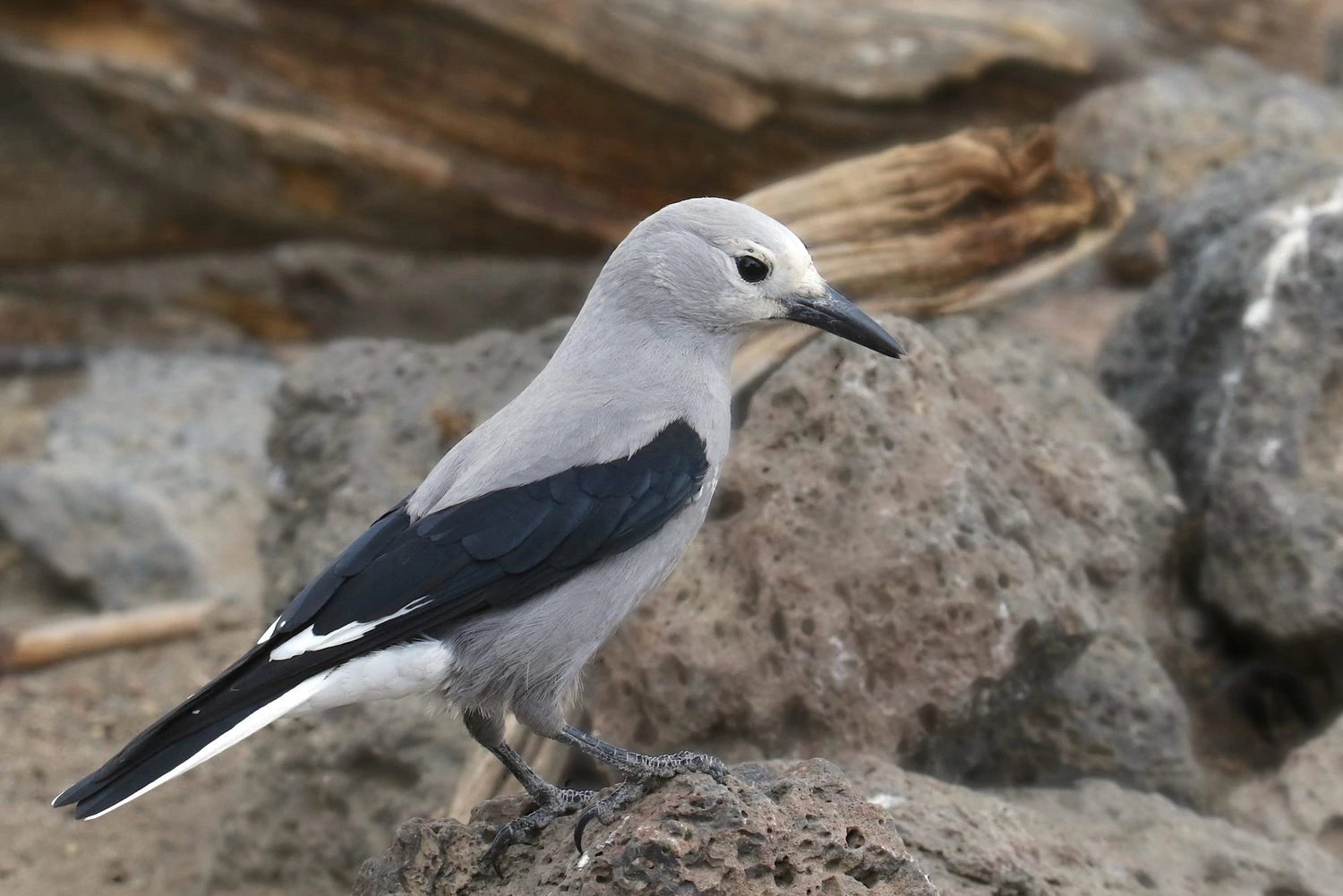
Clark’s Nutcrackers are similar in appearance to Canada Jays, with the gray coloring. They have shorter tails than jays and lack the crest. Clark’s Nutcrackers are light gray with black wings and tails with white patches.
- Nucifraga columbiana
- Length: 10.6-11.8 in (27-30 cm)
- Weight: 3.7-5.7 oz (106-161 g)
Clark’s Nutcrackers can be found all year in the pine forests of the mountainous west. They do not migrate but do move up to higher altitudes in the summer, and if pine crops are poor, they will move large distances.
Clark’s Nutcrackers mainly eat pine seeds fresh from the tree or those they have hidden away previously. They will occasionally eat insects, spiders, or small mammals if they get a chance.
Clark’s Nutcracker sounds:
Nests of Clark’s Nutcrackers are made in conifer trees and are made from sticks and twigs and lined with wood pulp, followed by soft dry grass and moss.
They lay 2 – 6 eggs, and these take around two and a half weeks to hatch and a further three weeks to fledge.
Attract Clark’s Nutcrackers to your backyard with black oil sunflower seeds, peanuts, and suet.
Fun Fact: Clark’s Nutcrackers have been recorded as far as Northeastern US states, when cone crops are poor, a distance of up to 2000 miles!
21. Pinyon Jay
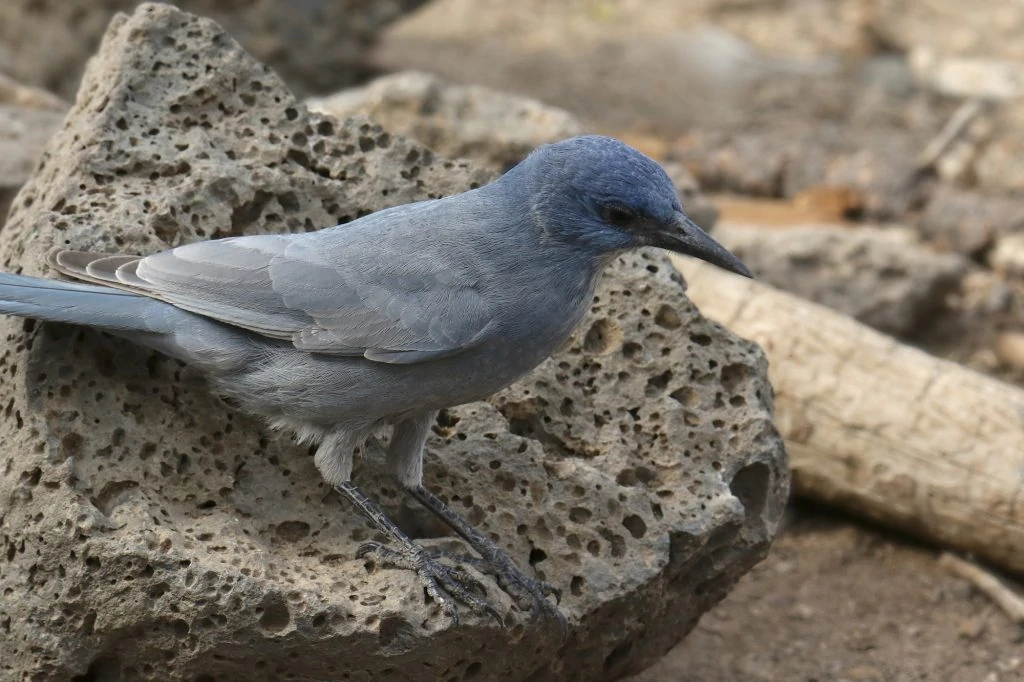
Pinyon Jays are blue all over, with darker backs and paler bellies. They also have white throats, shorter tails, and do not have crests like other Jays, like Stellar’s Jays. Males and females look the same, but juveniles can look more grayish-blue.
- Gymnorhinus cyanocephalus
- Length: 10.2-11.4 in (26-29 cm)
- Weight: 3.2-4.2 oz (90-120 g)
- Wingspan: 18.1 in (46 cm)
Pinyon Jays are resident inland in western US states in pinyon-pine forests.
As well as seeds from pinyon-pine, Pinyon Jays will eat juniper berries, acorns, and other animals such as lizards, baby birds, and insects. They are opportunity feeders who will take most things and forage in large, noisy groups.
Pinyon Jay sounds: They make 3 ‘kaw’ like calls close together that rise and then fall and sometimes shake or tremble.
Nests of Pinyon Jays are built of sticks and grass in pine trees and lined with feathers and animal hair.
Fun fact: Pinyon Jays do not have feathers over their nostrils to prevent the sticky pine pitch from making them dirty.
22. Canada Jay
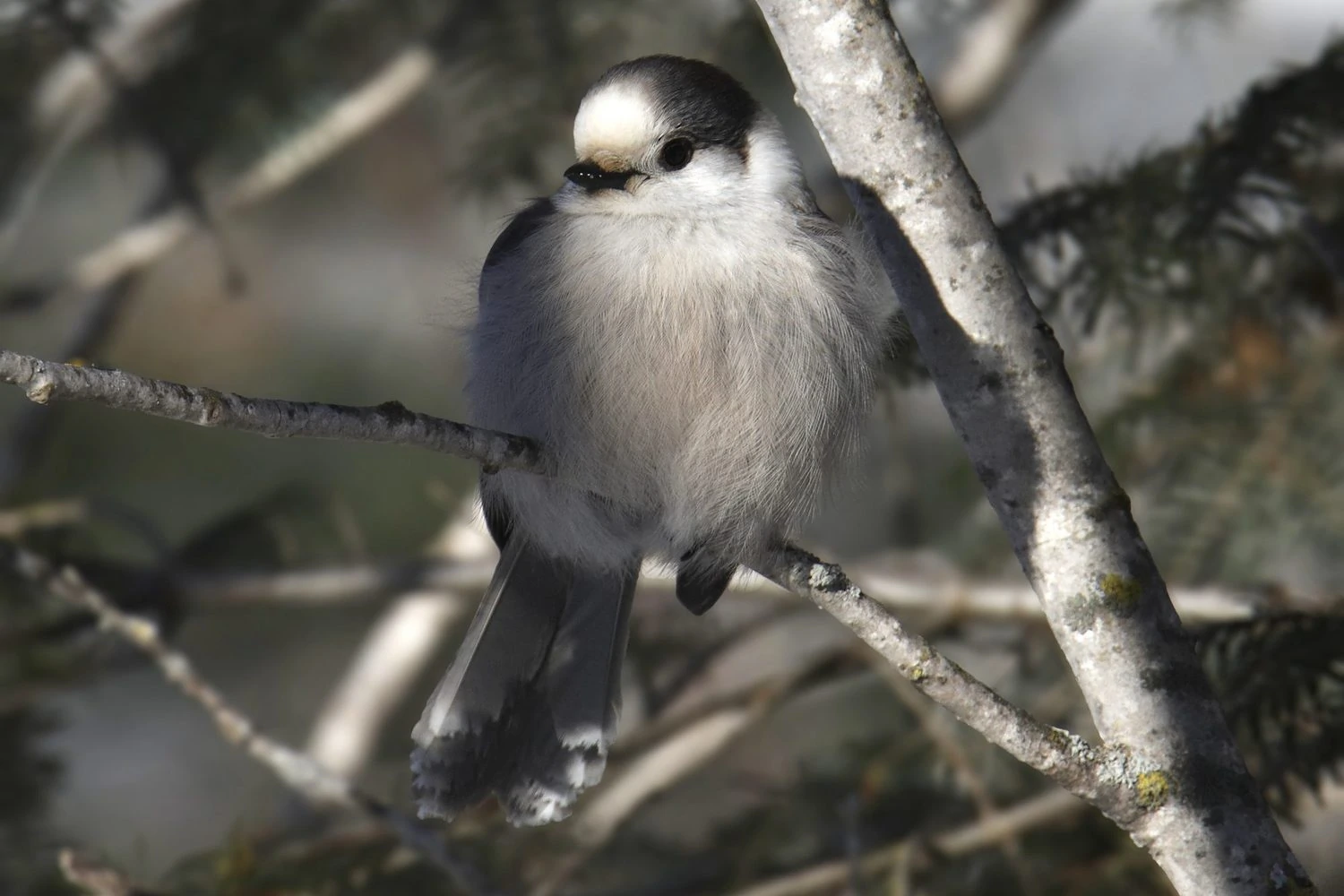
Canada Jays are dark gray on the back and a soft pale gray below. They have white heads and throats, with a black band running around the back of the head.
They are sometimes known as Grey Jays. Females look the same as males, but juveniles are darker gray all over.
- Length: 9.8-11.4 in (25-29 cm)
- Weight: 2.0-3.0 oz (58-84 g)
Canada Jays are resident in Canada, Alaska, and the high mountains of the northwest US. Some color differences occur with Canada Jays from different areas. With those in the Rockies being paler than those in Canada.
You can find Canada Jays in boreal forests where spruce trees are common. They are not as loud as other Jays and are opportunity feeders, eating a wide variety of food, including insects, berries, and dead animals. They will also come close, looking for food dropped by hikers.
Although they look sweet, Canada Jays have a deadly side, and they will kill baby birds for food and even hunt smaller species such as chickadees and warblers.
Canada Jay sounds: They have a gentle whispered song but often make harsher calls and clatters. Canada Jays can also imitate other species.
Nests of Canada Jays are built early in conifers when there is still snow around. The nest is made from dead twigs and is lined with feathers, and built on the south side of the tree for warmth.
Attract Canada Jays to your backyard with most kinds of bird food, such as seeds and suet, and they will readily eat from tube or platform feeders.
Fun fact: Canada Jays produce special saliva, which they use to mold food into a sticky blob, and then they stick it in a hiding place like gum under a desk.
23. Mountain Chickadee
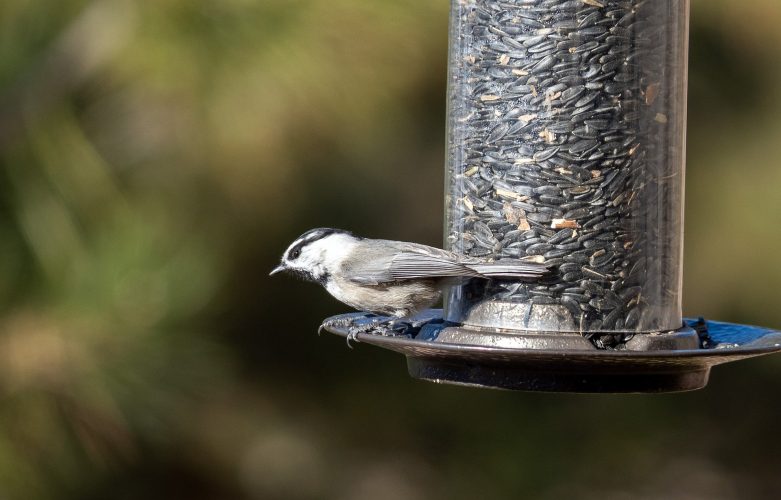
Mountain Chickadees are tiny birds with black-and-white heads and gray over the body, darker on the back and light gray underneath.
- Poecile gambeli
- Length: 4.3-5.5 in (11-14 cm)
- Weight: 0.4 oz (11 g)
Mountain Chickadees live in the mountains west of the US all year and do not migrate but may move down the mountain to lower areas in winter.
You can find Mountain Chickadees in evergreen forests, especially those with pine and conifers. They eat insects and spiders, nuts, and seeds and will often visit backyard feeders. Mountain Chickadees will often stash food for later and create a store of food.
Nests of Mountain Chickadees are usually in old nesting holes of woodpeckers and nuthatches. The female lines the cavity with fur and even covers her eggs when she leaves. They lay up to nine eggs, which take around two weeks to hatch and a further three weeks for the young to leave the nest.
Attract Mountain Chickadees to your yard by putting up nest boxes, and they will visit most types of feeders with black oil sunflower seeds, mealworms, nyjer, suet, and peanut butter.
Fun fact: The eggs of Mountain Chickadees are incubated 50% longer than other chickadee species, probably due to the protection that their old woodpecker nests give and the fact the female covers the eggs when she leaves.
24. Chestnut-backed Chickadee
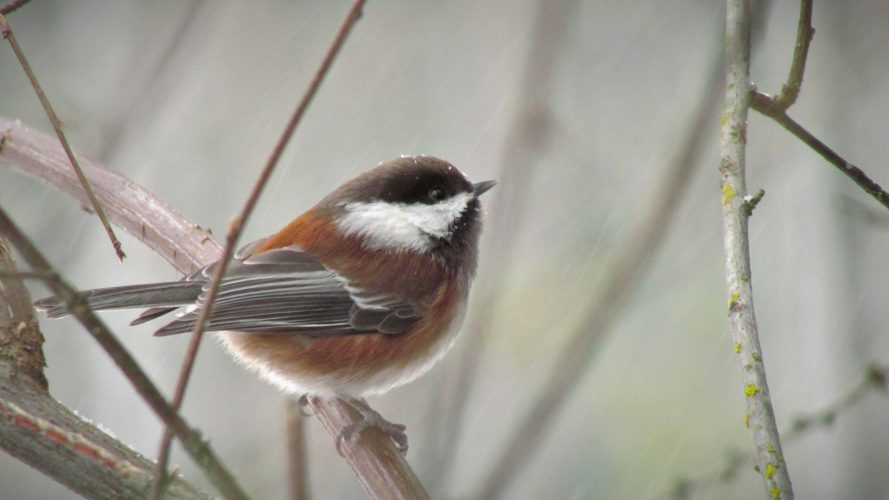
Chestnut-backed Chickadees are tiny birds with black caps and throats and white cheeks. They are a rich chestnut on their backs and sides and have gray wings and bellies. In California, their sides are gray instead of brown.
- Poecile rufescens
- Length: 3.9-4.7 in (10-12 cm)
- Weight: 0.3-0.4 oz (7-12 g)
- Wingspan: 7.5 in (19 cm)
Chestnut-backed Chickadees live flocks in wet evergreen forests along the Pacific Coast and are regular visitors to backyard feeders.
You can find Chestnut-backed Chickadees usually in conifer forests. They eat mostly insects, including caterpillars, spiders, wasps, and aphids, with seeds, berries, and fruit making up the rest.
Nests of Chestnut-backed Chickadees are usually holes in rotten wood made either by the birds themselves, or they use old woodpecker nests. The nest is lined with moss and bark, and then softer material such as fur and grass is added. They lay up to eleven eggs, which take around two weeks to hatch and nearly three weeks for the young to leave the nest.
Attract Chestnut-backed Chickadees to your yard with black-oil sunflower seeds, suet, nyjer, peanuts, or mealworms in tube feeders, platform feeders, or suet cages. They will also use nest boxes.
25. Boreal Chickadee
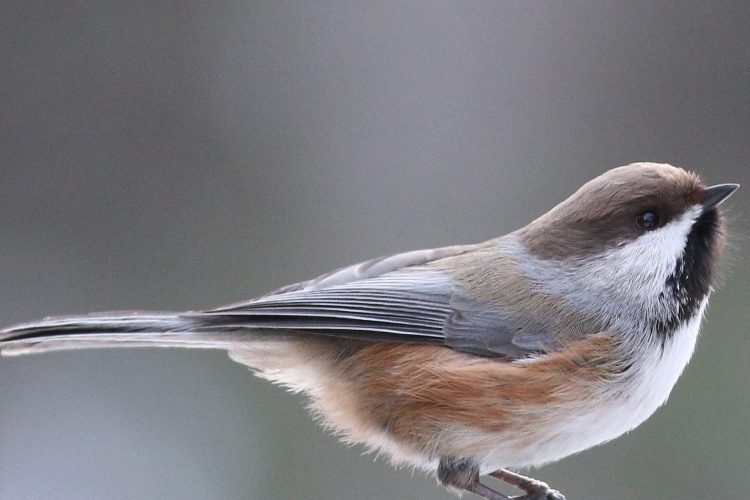
Boreal Chickadees are tiny grayish-brown songbirds with a dark brown cap, small black bib, cinnamon sides, and white underneath and on the cheeks.
- Poecile hudsonicus
- Length: 4.9-5.5 in (12.5-14 cm)
- Weight: 0.3-0.4 oz (7-12.4 g)
Boreal Chickadees live in Canada and Alaska and may appear in northern US states.
You can find Boreal Chickadees mostly in coniferous forests, often near water, but also can be found in deciduous or mixed forests. They feed on seeds and insects from the upper areas of the canopy and will readily visit feeders.
Nests of Boreal Chickadees are usually in dead trees, and the hole is made by the female. Moss and bark are used to line the cavity, and then softer material such as hair and feathers is added. They lay up to nine eggs, which take just over two weeks to hatch.
Attract Boreal Chickadees to your backyard with Black oil sunflower seeds, nyjer seeds, suet, peanuts, and mealworms on most types of feeders. Also, put up a nesting box to attract a mating pair.
Fun Fact: Boreal Chickadees will store seeds and insects for the long and harsh winter.
26. Bewick’s Wren
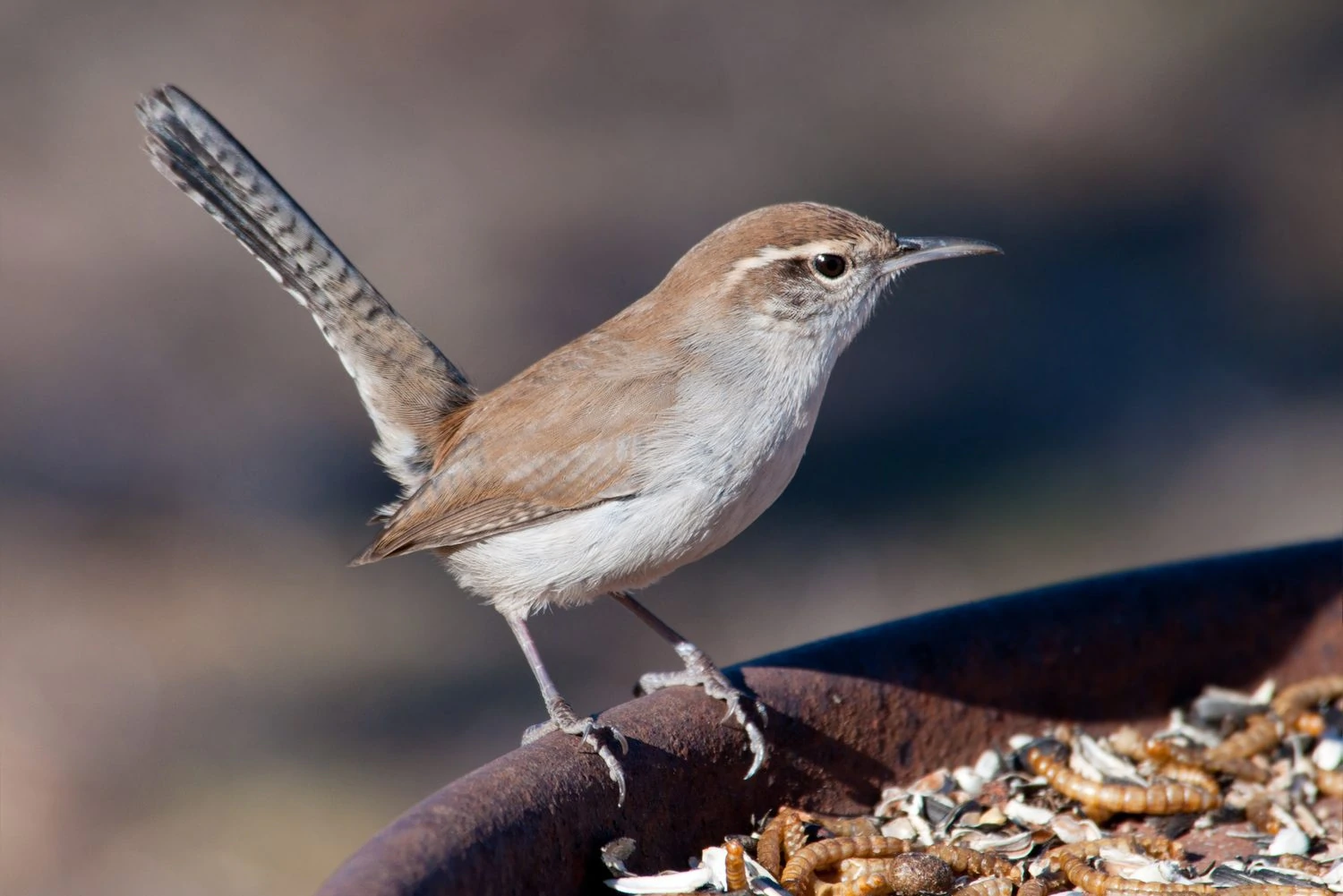
Bewick’s Wrens are brown-backed birds with long gray upright tails with darker barring. They have gray bellies and a white stripe over the eye.
- Thryomanes bewickii
- Length: 5.1 in (13 cm)
- Weight: 0.3-0.4 oz (8-12 g)
Bewick’s Wrens live in southern and western states all year with some small movements in winter.
You can find Bewick’s Wrens in scrub, thickets, and open woodland, hopping from branch to branch, flicking their long tails.
They feed on insects and larvae, including bees, bugs, caterpillars, and beetles.
Bewick’s Wren sounds: Their song starts with a couple of short higher notes, followed by lower-pitched buzzy notes.
Nests are on rock ledges, old woodpecker nests, nest boxes, or crevices in buildings. They are cup-shaped and made from sticks and grasses with a softer lining. Thye lay 3 – 8 eggs, and hatching takes around two weeks and fledging a further two weeks again.
Attract Bewick Wrens to your backyard with suet, mealworms, and hulled sunflower seeds.
Fun fact: The House Wren is probably responsible for the unfortunate decline of Bewick Wrens in the eastern US as they would destroy their eggs.
27. Cactus Wren
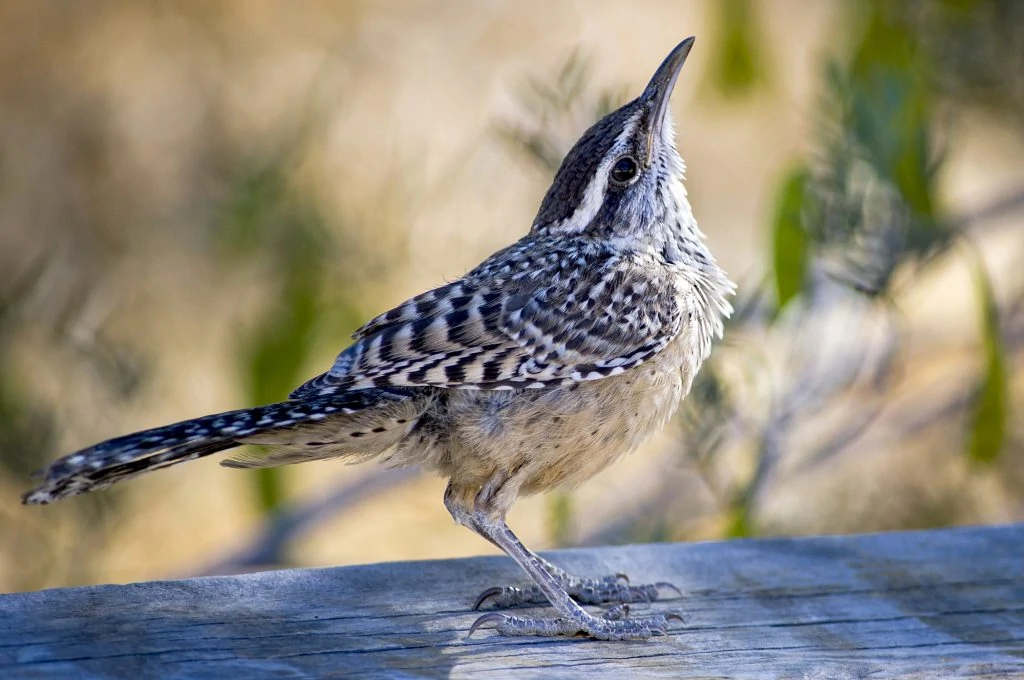
Cactus Wrens are easier to recognize with their speckled undersides, large bold eyebrow stripe, and large size. They are brown on the back with lots of streaking.
Cactus Wrens do not have an upright tail like most wrens. Instead, they fan their tails out to show the white tips.
- Campylorhynchus brunneicapillus
- Length: 7.1-8.7 in (18-22 cm)
- Weight: 1.1-1.7 oz (32-47 g)
Cactus Wrens are residents in dry areas in southwestern states from California to Texas and Mexico.
You can find Cactus Wrens, unusually for wrens, out in the open at the top of a cactus, singing or eating the cactus fruit. They can also be seen on the ground hunting for insects and spiders by turning over leaves and other debris.
Cactus Wren sounds: They make a distinctive buzzy two-tone song that often rises in volume as it goes along.
Nests of Cactus Wrens are round-shaped with a small tunnel entrance in desert vegetation. They lay 2 – 7 eggs, which hatch in around two and a half weeks, and the chicks fledge in around three weeks.
Fun fact: Cactus Wrens do not need to drink water, which is handy in the desert, and instead get all they need from insects and fruit.
28. Bushtit
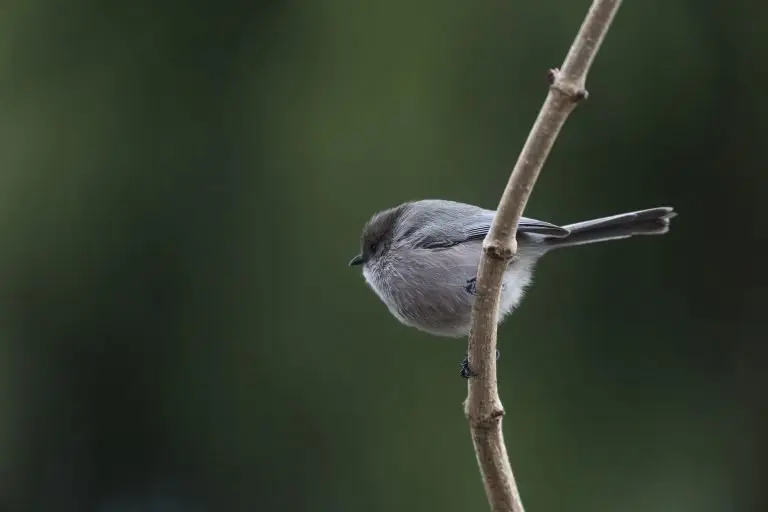
Bushtits are tiny, almost round, soft gray birds with long tails and stubby bills. They have slight brown tinges to the face and underneath.
- Length: 2.8-3.1 in (7-8 cm)
- Weight: 0.1-0.2 oz (4-6 g)
Bushtits live all year in western US States.
They can be found in open woodland or scrubby areas, parks, and backyards. Their diet is insects and spiders, such as caterpillars, beetle, wasps, and ants.
Bushtits make amazing hanging nests out of plant material and spider webs that hang down about a foot and may take a month to build.
To attract more bushtits to your yard, plant native shrubs and trees, and they may visit feeders filled with black oil sunflower seeds, suet, or mealworms from platform feeders.
29. Pine Warbler
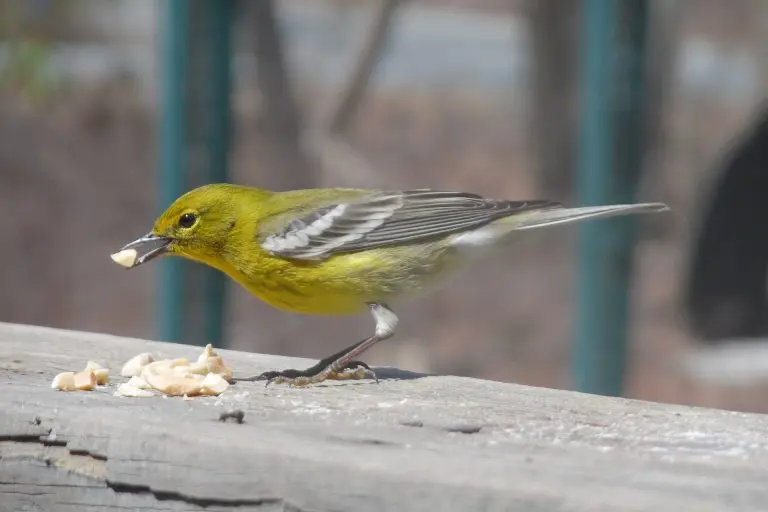
Pine Warblers are small plump yellow birds with olive backs, white lower bellies, and gray wingbars. Females can appear browner and have more white on the belly.
- Setophaga pinus
- Length: 5.1-5.5 in (13-14 cm)
- Weight: 0.3-0.5 oz (9-15 g)
- Wingspan: 7.5-9.1 in (19-23 cm)
Pine Warblers breed in northeastern US states before heading to southeastern US states. Some remain all year in southeastern US states.
You can find Pine Warblers in pine forests, as their name would suggest, often high up in the trees. They eat caterpillars, beetles, spiders, and other insects and larvae, and when the weather is colder, they will eat fruit and seeds.
Pine Warbler Song:
Nests of Pine Warblers are, as you would expect, in pine trees! They are made from twigs, bark, pine needles, and grass, bound with spiders silk and lined with feathers and animal hair. They lay up to five eggs which take up to two weeks to hatch and another ten days for the young to leave the nest.
Attract Pine Warblers to your yard with tube feeders and platform feeders with millet, cracked corn, sunflower seeds, peanut hearts, and suet. Also, plant native fruits and vines such as bayberry, grape, sumac, and Virginia creeper.
Fun Fact: Pine Warblers are one of the only warblers to eat seeds mainly, and so you are more likely to see them at backyard feeders.
30. Northern Cardinal
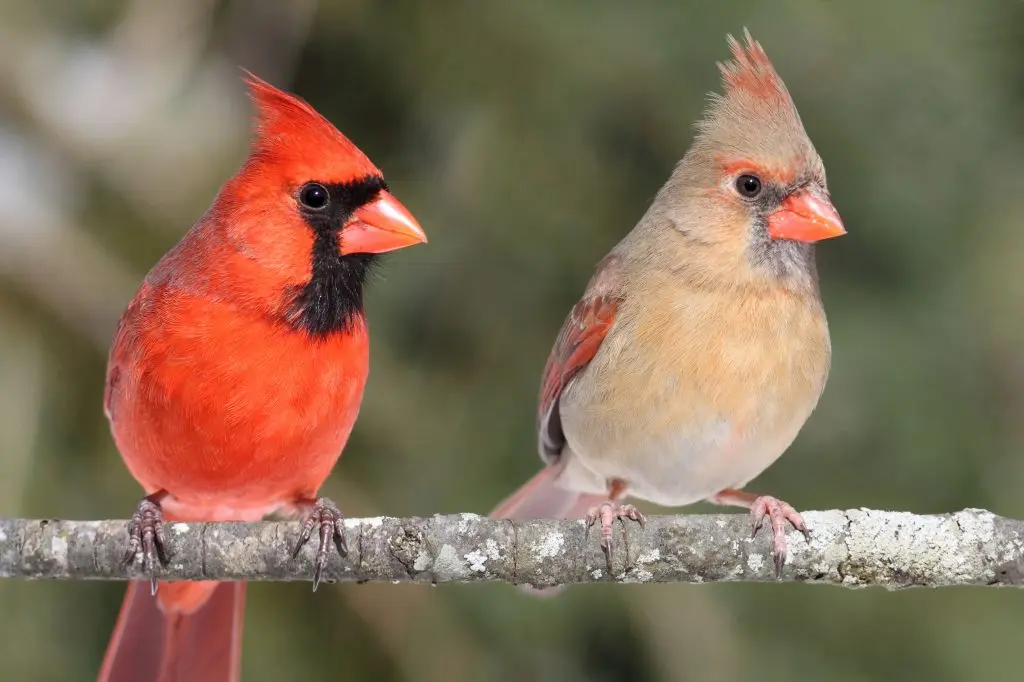
The bright red male Northern Cardinal with black around their faces is an incredible sight, especially against a white winter background. They also have red crests and beaks.
Females are also a little showy with their brown coloring, sharp brown crest, red highlights, and red beaks.
- Cardinalis cardinalis
- Length: 8.3-9.1 in (21-23 cm)
- Weight: 1.5-1.7 oz (42-48 g)
- Wingspan: 9.8-12.2 in (25-31 cm)
Northern Cardinals live in the Eastern half of the US and some states in the south as far west as Arizona.
You can find Northern Cardinals in dense vegetation foraging for seeds, fruit, and insects. Northern Cardinals will sometimes attack their own reflection during the breeding season as they obsessively defend their territories.
Northern Cardinal Song:
Attract Northern Cardinals to your backyard with feeders full of sunflower seeds, peanut hearts, millet, and milo. They will feed from large tube feeders, hoppers, platform feeders, or food scattered on the ground.
31. Brown Thrasher
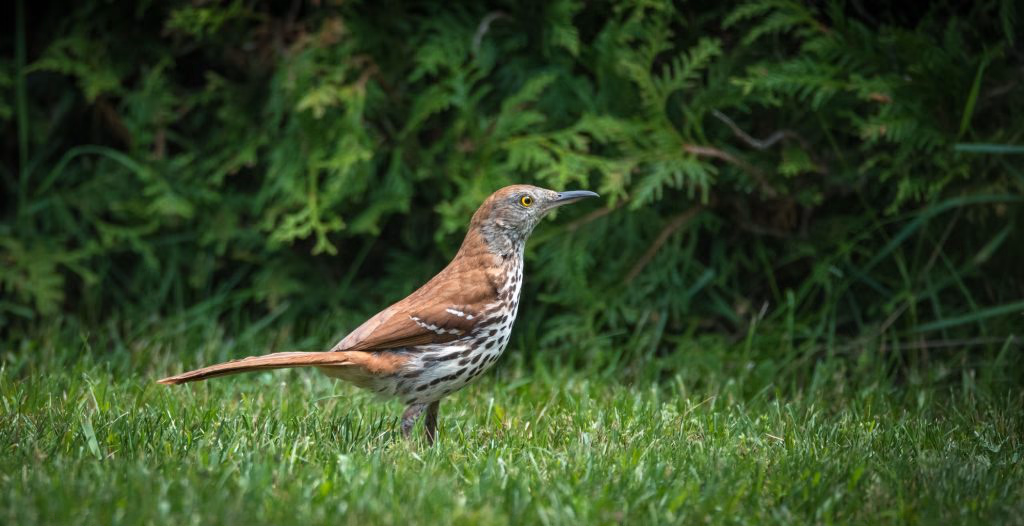
Brown Thrashers are large songbirds with long proportions. They are about the same size as a robin. They are brown on the back and with white-streaked chests and bellies. Their faces are gray with bright yellow eyes.
- Length: 9.1-11.8 in (23-30 cm)
- Weight: 2.1-3.1 oz (61-89 g)
- Wingspan: 11.4-12.6 in (29-32 cm)
Brown Thrashers live in central and eastern North America. Those birds in the southeast of their range remain all year, but birds further north migrate south for the winter.
Brown Thrashers are hard to spot for their size as they spend most of their time in thickets and shrubbery. However, they can be heard rummaging along the ground in the leaf litter and soil, looking for insects.
Brown Thrashers also eat berries, beetles, and flying insects from the air. They may come to your backyard if there is dense cover and berry shrubs and they collect fallen seed from under feeders.
Over 1000 different song types are sung by these most accomplished songbirds, which is one of the largest of any North American songbird.

